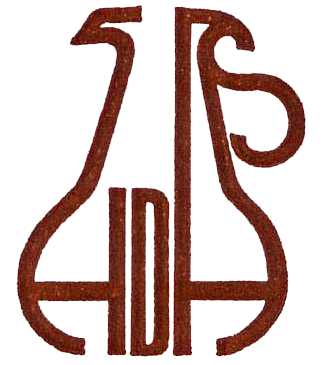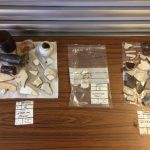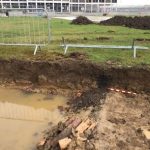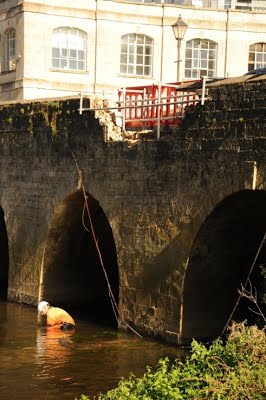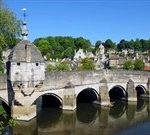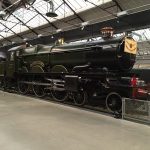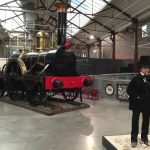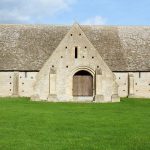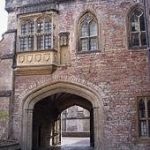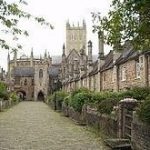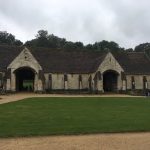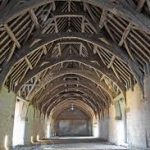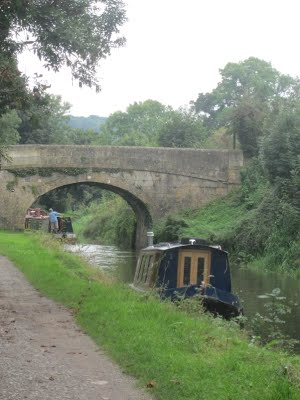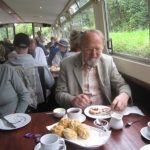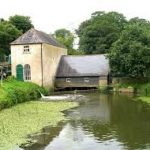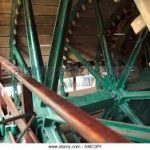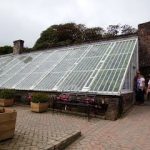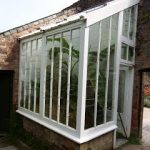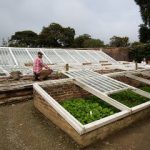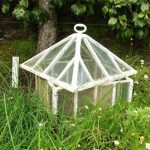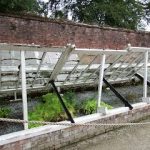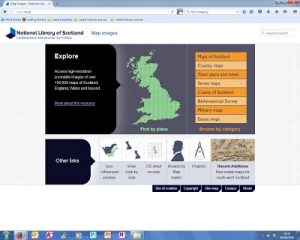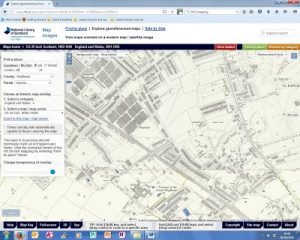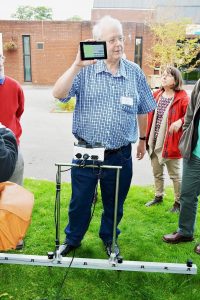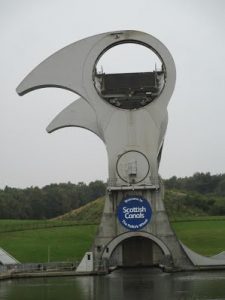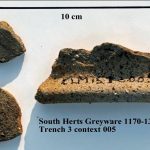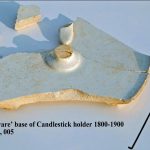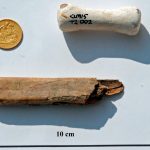born 1813
Field Research Bill Bass reports: “Following our survey at Copped Hall near Waltham Abbey, Dennis Hill of the Enfield Archaeology Society asked HADAS if we could conduct a similar survey at a site in their area. This site is Bowling Green House in the grounds of Myddelton House just north of Forty Hall in the Bulls Cross area of Enfield.”
Myddelton House is named after Sir Hugh Myddleton, who constructed The New River in 1610-1614 to carry drinking water from natural springs at Amwell in Hertfordshire into central London along a 38 mile man-made channel. A section of this river once ran through the gardens but has now been filled in. Myddelton House replaced a Tudor building called Bowling Green House, the remains of which lie under the gardens, it was a 12 room, red brick, gabled structure that was demolished in 1812 when the present house was finished. This part of the garden is now a lawn and flowerbeds, in the 1980s when a water pipe was being laid, the gardener came across some brick foundations thought to be in the area of the Tudor House.
 Following a site visit (mentioned in the last Newsletter), we decided to conduct a resistivity survey over the weekends of the 13/14 and 20/21 October. The first weekend was completely washed-out weather wise so the survey was completed in one day (21st), which was also timed as a public open day so visitors could see what we were up to. Members of the West Essex Archaeological Group who had invited us to Copped Hall joined us. The survey went well in sunny conditions (at last!) we also set-up a bookstall where Andy Simpson tried to sell his wares (he wasn’t having much luck) and explaining what we were doing.
Following a site visit (mentioned in the last Newsletter), we decided to conduct a resistivity survey over the weekends of the 13/14 and 20/21 October. The first weekend was completely washed-out weather wise so the survey was completed in one day (21st), which was also timed as a public open day so visitors could see what we were up to. Members of the West Essex Archaeological Group who had invited us to Copped Hall joined us. The survey went well in sunny conditions (at last!) we also set-up a bookstall where Andy Simpson tried to sell his wares (he wasn’t having much luck) and explaining what we were doing.
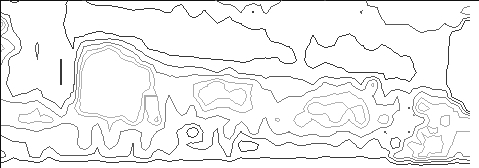 A 15 x 40m grid was laid out over the flat lawn known as Tom Tiddlers Ground with survey points at 1m intervals. Christian Allen compiled the results, (figure 1) shows a dot-density plot of the data. The plot strongly indicates a long linear structure across the northern half of the area. This appears to be part of a much larger structure. The contour plot (figure 2) shows that the structure has clearly defined edges, which implies that this is possibly a wall, its foundation, or similar construction. Given the strength of these results, the feature found is possibly a wall, or similar, belonging to a much larger structure. This implies that these may be part of the remains of the Tudor manor house that was previously situated in the grounds of the current Myddelton House. (See the results on page 2).
A 15 x 40m grid was laid out over the flat lawn known as Tom Tiddlers Ground with survey points at 1m intervals. Christian Allen compiled the results, (figure 1) shows a dot-density plot of the data. The plot strongly indicates a long linear structure across the northern half of the area. This appears to be part of a much larger structure. The contour plot (figure 2) shows that the structure has clearly defined edges, which implies that this is possibly a wall, its foundation, or similar construction. Given the strength of these results, the feature found is possibly a wall, or similar, belonging to a much larger structure. This implies that these may be part of the remains of the Tudor manor house that was previously situated in the grounds of the current Myddelton House. (See the results on page 2).
After the earlier site visit to Myddelton House the team were shown around a current excavation being carried out by the Enfield Archaeological Society elsewhere. The site to the south of the town near the A10 was in a small back garden but was turning up big results in the form of Roman finds pottery etc as well as post holes and gullies. The area is thought to be a possible farm perhaps near-to or adjacent to a Roman posting-station positioned on Ermine Street now followed by the line of the A10.
Note: From January 2002 Newsletter (Number 370).
Number 552 MARCH 2017 Edited by Deirdre Barrie
HADAS DIARY – LECTURE PROGRAMME 2017
Tuesday 14th March 2017: A Very Secret War: Trent Park & Bugging the Nazis in WW2, by Dr Helen Fry.
During WW2, British Intelligence bugged the conversations of over 10,000 German Prisoners-of-War at three clandestine stately houses. Trent Park was reserved for Hitler’s Generals – they were housed in luxurious conditions in what turned out to be one of the greatest deceptions of the wartime. Lulled into a false sense of security, the Generals relaxed and became unguarded in their conversations. They inadvertently began to give away some of Hitler’s most closely-guarded secrets. Having worked through the declassified files, historian Dr Helen Fry sheds light on one of the least-known, but greatest deceptions of WW2.
Historian Dr. Fry has written numerous books on the Second World War. Her book The M Room: Secret Listeners who Bugged the Nazis has been optioned for a feature film, and was the subject of the Channel 4 documentary Spying on Hitler’s Army. Helen has written over 20 books, including Spymaster: the secret Life of Kendrick; Freud’s War; From Dachau to D-Day; and Churchill’s German Army.
Tuesday 11th April: Where Moses Stood – Robert Feather.
Tuesday 9th May 2017: The Cheapside Hoard by Hazel Forsyth
Tuesday 13th June 2017: ANNUAL GENERAL MEETING
Monday 25th-Friday 29th September: HADAS Trip to Frodsham.
Tuesday 10th October 2017: “The Curtain” Playhouse Excavations, by Heather Knight, MOLA
Tuesday 14th November 2017: The Battle of Barnet Project, by Sam Wilson.
Lectures are held at Avenue House, 17 East End Road, Finchley, N3 3QE, and start promptly at 8 pm, with coffee/tea and biscuits afterwards. Non-members: £1. Buses 82, 125, 143, 326 & 460 pass nearby, and Finchley Central station (Northern Line) is a 5-10 minute walk away.
Mary Phillips – HADAS Vice President Jo Nelhams
Mary Phillips was appointed a Vice-President at the AGM on Tuesday 5th May 1992 at Hendon Library. At that time there were discussions concerning the high cost of the Garden Room at Avenue House, in which the Sunday morning group were already meeting. A member of HADAS at the time named Andrew Pares, who was a former Mayor, suggested that Councillor Mary Phillips should be invited to be a Vice-president as she may be able to be of assistance.
Although I was not a member of HADAS at the time, I did know Mary and had met her sometime in 1977. She was born in Finchley and lived in the area for all her life. As a child, she attended Manor Side School and later went to Henrietta Barnett School. During the war, so her daughter tells me, when the siren sounded, the girls would hide in a cupboard.
Mary trained as a teacher at Doncaster Training College and then returned to Finchley and met her future husband, Godfrey, at the Young Conservatives. Mary spent most of her teaching career at Goodwyn School in Mill Hill, which is where I met her.
She served as a Councillor for many years and was always trying to sort out people’s problems. She and her husband were very involved with the organisation of Finchley Carnival, and Mary also organised events for raising funds each year for the Mayor’s appeal, with a sponsored swim at Copthall Pool, as well as musical social events at Church Farmhouse Museum. She was also on many other committees. She was one of life’s “doers”. She maintained her interest in HADAS, and always read the Newsletters until this became impossible for her.
Mary passed away recently, and as I reported at last Year’s AGM, she was being cared for in a home in Cockfosters where she had been for a few years.
Congratulations to Dorothy Newbury
Surely our oldest member, Dorothy Newbury celebrated her 97th birthday recently. HADAS Committee and members send their best wishes and congratulations.
Archaeological Watching Brief – RAF Museum, Hendon
6 February 2017 Andy Simpson
This work was undertaken by Curator of Aircraft and Exhibits and member of local group Hendon and District Archaeological Society (HADAS), Andrew Simpson.
Site access via the contractors (SDC builders Ltd) was arranged by RAFM Centenary Programme Manager Rebecca Dalley and Steve Johnson, SDC Site Manager, to whom thanks. The provisional site code RAFMH17 was allocated. NGR TQ22079039.
Background
Much of the RAF Museum Hendon site is currently being redeveloped as part of a major Heritage Lottery Fund (HLF)-funded project to mark the Centenary of the Formation of the Royal Air Force (RAF) on 1 April 1918.
Part of this work involves major ground works to change the layout of the external parts of the site. To this end, the contractors have excavated a number of machine-cut trenches to check for services and ground conditions. On the western part of the site this involves the replacement of a large grassed area by car parking. This area served for many years as an occasional visiting helicopter landing pad and events area.
The Curator of Aircraft suggested that the opportunity be taken to investigate the excavated trenches for any archaeological features or finds of interest.
Until creation of the original aerodrome from February 1910, the area occupied by the RAF Museum and former RAF Hendon appears to have been low-lying and fairly boggy pasture land with many trees. The nearest major archaeological evidence lies to the east on the area of Greyhound Hill and Hendon Burroughs, where work by HADAS and others mainly since the 1960s has established evidence of undefined Romano-British occupation of first-fourth century date, possibly of agricultural/farming nature, plus evidence of Saxon occupation from at least the seventh/eighth century, and Saxo-Norman occupation; then virtually continuous occupation through to the modern day, other than a possible hiatus around the time of the Black Death.
In November 1992, a professional archaeological watching brief was carried out by Museum of London archaeologists, covering five machine-cut trenches, cut to a depth of 50cm, on the site of the new Colindale Police Station, within the former RAF Hendon East Camp, immediately adjacent to Hangar One (the former Battle of Britain Hall), found only underlying London clay, modern field drains and 17th-18th century pottery and clay pipe. (Site code GPW92; NGR TQ2193 9011). This was reported in HADAS Newsletter 261, December 1992.
Field drain cut Finds
It was suspected that similar material might be found at the museum site. Andy Renwick, Curator of Photographs and writer of “RAF Hendon The Birthplace of Aerial Power” (Crecy, 2012), suggested that field drains dating to RAF improvements to the site drainage in the summer of 1926 would be likely to be found. The London Aerodrome was created on land leased by the Brinckman family, with the area now occupied by the museum and its grounds forming part of one large field in the main, with a field boundary, as indicated by contemporary maps, running SW from roughly the centre of the current main building.
The Investigation
An afternoon was spent investigating three machine-cut trenches and their adjacent spoil heaps, and disturbed ground around the edges of the trenches, using a hand trowel only.
The first trench investigated was the long one running N-S at the centre of the former helicopter pad. The west-facing section was cleaned and showed a top turf humic layer some 5cm thick; all recovered finds appeared to originate from this context, 001. It overlay a hard-packed clay subsoil some 20cm thick, context 002, which appeared to be virtually sterile other than for one or two very small flecks of red brick or tile. This in turn overlay natural London clay, 003. Contexts 002 and 003 were cut by two lines of field drain running approximately east–west across the trench (presumed to be those laid in 1926 as referred to above), lying in an ash/clinker-lined cut, the ash/clinker including some fragments of modern pottery (not retained). The field drain sections in unglazed red earthenware fabric varied slightly in length, but a recovered example is 298mm in length with an external diameter of 11cm and a central bore of 75mm.
Recovered finds from this trench include three short lengths of updateable clay pipe stem, and a selection of modern stonewares and earthenwares. This was the trench with the least evidence of recent ground disturbance.
The second trench investigated, to the north adjacent to the main gate, showed much more evidence of recent disturbance, with a thick (20-25cm depth) but unevenly spread layer of ash/clinker running across the trench just below the turf/topsoil line (which was noticeably deeper in this trench – average 20cm), and overlying the natural London clay. Andy Renwick points out that in 1926 the little-used former railway spur running around the site boundary from Silkstream Junction on the Midland Railway main line across Aerodrome Road to sidings fronting the Edgware Road was lifted, and its ballast used to fill an area of boggy ground near the former Aerodrome Hotel; this may be more of that same material, lying just below the current turf line. Finds from this trench were limited to just three small sherds of pottery. Investigation was limited by waterlogging of much of this trench after recent heavy rainfall.
The third trench was the southernmost, just to the north of Hangar One. This again showed considerable evidence of recent disturbance, with much ash/clinker forming a layer between the topsoil and natural clay, containing modern pottery and glass including bottle necks. Site manager Steve Johnson suggested this may be redeposited rubble from the London Blitz. Certainly very similar material was used to backfill an uncompleted air raid shelter at Martin School, East Finchley, investigated by HADAS in 2013. Investigation was again limited by waterlogging of much of this trench after the recent heavy rainfall.
A brief check was made of two or three very small square trenches to the east of these three main trenches. These had been dug over the line of services and no features or finds were noted.
The Finds
A selection of the recovered finds was kindly examined by Jacqui Pearce FSA, pottery specialist for Museum of London Archaeology (MOLA).
There was a good selection of Victorian and later pottery from the central trench. This included a ribbed body sherd of stoneware – possibly a marmalade jar – a rim sherd of a bone china serving dish with floral decoration; part of a stoneware bottle; part of a redware lid, probably from a teapot; a section of handle from a Victorian Rockingham-type earthenware teapot, originally made near Rotherham in South Yorkshire (MOLA code ROCK, 1800-1900); and refined white ware body sherds. There was also a single piece of partially fire-melted green bottle glass, and a similarly fire-damaged sherd of stoneware, the latter two possibly analogous with the material from the Hangar One trench.
The three small sherds from the ‘Bloodhound Trench’ include two of Refined white earthenwares (MOLA code REFW, 1805-1900) – one a section of foot rim – and a rim sherd of Transfer Printed Ware (TPW, 1780-1900).
The trench nearest Hangar One yielded a selection of relatively recent material, including a complete small brown glass screw-top jar and a white glazed and almost complete possible salt shaker with a hole at base for adding the salt. There were two glass beer-type bottle necks in clear and brown glass, part of a stoneware jar/bottle base and several fragments of white glazed plates, both plain and decorated. All of this could well match the suggestion of dumped ‘Blitz Rubble’ in this area. There was also a small white ware sherd with the transfer printed maker’s mark ‘Grindley England’ – W.H. Grindley were a Potteries-based manufacturer based in Tunstall; this ‘sailboat’ makers’ mark being dated 1936-1954; see http://www.thepotteries.org/mark/g/grindley.htm
Conclusions
This was a useful exercise in confirming that in this part of the site at least there appear to be no significant archaeological features. It is interesting that the small selection of finds recovered are virtually all of Victorian or later date, with no sign of the earlier pottery recorded just next door on the Police Station site. Only the clay pipestems may be a little earlier, but clay pipes did remain in fairly general use until the Great War period, when supplanted by cigarettes. Any further site observation may be taken as appropriate, and the finds retained for possible formal/informal display to various museum stakeholders and audiences.
Cromer Road School History Award Jim Nelhams
Cromer Road School, where we dug in 2014 and 2015, has received a Silver Award from the Historical Association for their study of history over the last three years. Reports of the digs from Bill Bass have appeared in our Newsletters. The citation includes the following words: –
“The school keenly promotes learning outside the classroom and has been involved in a Big Dig project where pupils have undertaken their own excavations on the school site and surrounding area.”
It is nice to know the positive effect that the work of our digging team has contributed to the school.
Church Terrace Excavation – “the copper-alloy pin” Alec Jeakins
I dug on this site, and remember an excited Ted Sammes showing me this Saxon spiral-headed pin one morning at the start of a day’s digging. (See p.67 of “A Hamlet in Hendon” 2014)
Recently I was looking at the catalogue of “The Making of England – Anglo-Saxon Art and Culture AD 600-900” an exhibit which was held at the British Museum in 1991. A photograph on page 98 shows two very similar pins to the Church Terrace example from the S. Humberside, Flixborough site – a particularly well-preserved high-status site. The finds are in the Scunthorpe Museum. At the time of the exhibition, detailed analysis and phasing of the site had not been resolved, but it was stated that all the finds date from the eighth or ninth century.
The Flixborough pins are not mentioned in the “A Hamlet in Hendon” Report when reviewing other examples. These pins are slightly shorter than the Church Terrace pin, i.e. 570mm & 515mm rather than 161mm, and the spirals are not so tightly wound.
Add these two pins to the York find mentioned in the review, and it would suggest a wider distribution than that of the southern and eastern England suggested in the Church Terrace report.
Membership Renewals by Stephen Brunning
The HADAS membership year runs from 1st April to 31st March, and so all members who pay by cheque will now be required to renew (except those people who have joined since January this year).
Please therefore find enclosed a renewal form, and I would ask that you fill it in and return it to me along with the appropriate amount as soon as possible. The current rates and where to send your payment are on the form. Many thanks.
If the renewal form is not enclosed and you require one, please contact me – Stephen Brunning Email: stephen@millhill1.plus.com
Bank of England Notes Jim Nelhams
In September of 2016, the Bank of England introduced a polymer £5 note. One comment was that the new note would survive in a washing machine, though I have not had the courage to test it. Since the introduction, the old notes have started to be withdrawn.
After 5th May 2017, the old notes will no longer be legal tender, though they can be banked at banks, building societies and the post office, so when this Newsletter is issued, you have just over two months left to use them in shops. Current plans are to introduce a new £10 note featuring Jane Austen this summer, and a new £20 note in 2020. There are no plans as yet to replace the £50.
Bradford on Avon – Final Day Jim Nelhams
Our last day on the trip. And because our hotel was some distance from the town, denying us the opportunity of exploring, we now had a little time to rectify the omission. We had spent time at the Tithe Barn on Wednesday (see January newsletter). Most people started with the Saxon church, though Simon had been there on the Wednesday.
After “doing the town,” we boarded our trusty chariot for a visit to the Steam Museum in Swindon, and thence to another tithe barn, this one at Great Coxwell.
St Laurence’s Church, Bradford on Avon Simon Williams
The church was probably a chapel built to house the body of Saint Anselm. Tall and narrow, it is delightful in its unaltered integrity inside and out, save one missing porch, with a sense of being windowless – in comparison with subsequent trends: as a place of inner peace and refuge within the precinct of a monastery: a sanctuary from the savage and ‘Godless’ world outside? It has miraculously escaped the heavy hands of the Normans, Gothic ‘improvers’, and the C19 ‘restorers’; as testimony to an astonishing time-warp it still stands apart, dominant in its own space. Recorded to have been founded c.675-709; and to be forgotten through time. Escaping through change of use: the nave as a tiny school, the chancel as a tiny dwelling, only to be rediscovered in 1856. The fine external stone pilaster stripwork dates from C10-11.
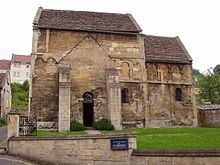 Only the austere Escomb Church near Durham, can rival it for age and preservation, though lacking its sense of place, being rather deplorably surrounded by a modern housing estate!
Only the austere Escomb Church near Durham, can rival it for age and preservation, though lacking its sense of place, being rather deplorably surrounded by a modern housing estate!
Bradford on Avon Museum Audrey Hooson
Today Bradford on Avon is an interesting, rather touristy market town. It is difficult to imagine it as the noisy, smoky centre of a manufacturing area. The local museum run, as so often, by volunteers, is housed in part of the modern Public Library building. Their room is quite small and densely packed with interesting exhibits. It was fortunate that our visit did not coincide with an excited school group.
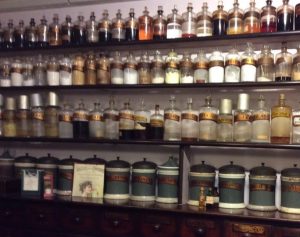 The sections on local industry and social history were particularly well displayed. The centre piece is the Christopher Shop. This pharmacy was established in 1863, and remained much the same until the final owner, Angela Mary Christopher, decided to retire in 1986. There was no buyer and the Bradford on Avon museum Society was formed to preserve the contents. This developed into the current museum, opened in 1990.
The sections on local industry and social history were particularly well displayed. The centre piece is the Christopher Shop. This pharmacy was established in 1863, and remained much the same until the final owner, Angela Mary Christopher, decided to retire in 1986. There was no buyer and the Bradford on Avon museum Society was formed to preserve the contents. This developed into the current museum, opened in 1990.
The Christophers were antiquaries and kept all the bottles, jars and pharmacy equipment from before the era of pre-packaged medicines.
Their shop has been reconstructed at one end of the museum, and the gleaming jars and mahogany shop fittings are very attractive. It is often used for films and TV when a period setting is required, usually for purchasing poisons
Past industry in the area has included weaving woollen cloth (first mentioned in 1540), iron and brass working, and vulcanised rubber manufacture (since 1848). It was a surprise to find that Moulton Bicycles were designed there in 1962 and are still made in the town.
In recent years, many of the industrial premises have been converted into private residences and shops are changing. The Museum Society retrieves and preserves as much as it can.
The Iron Duke Jim Nelhams
The Iron Duke (photograph below) is a piece of industrial archaeology of national importance. Built in 1849 for Stephen Moulton to start his rubber manufacturing business in Bradford on Avon, it was the first machine of its type in Europe. The Iron Duke is a rubber-rolling or calendering machine, vulcanising rubber and cotton fabric to make waterproof sheeting. The rubber industry grew to dominate life in Bradford.
When the Spencer Moulton factory closed in 1973, the Iron Duke was dismantled and stored at Bristol Museum, in the hope that one day it could be restored and put on public view. The Bradford on Avon Preservation Trust, the Bradford on Avon Museum Society and BoaCan (the Bradford on Avon Community area Network) joined forces to bring the Iron Duke back to Bradford on Avon, where it was a working machine for over 100 years.
The size and weight of the machine preclude siting it in the museum, so it was agreed to locate the restored Iron Duke on part of the old factory site. Planning permission was duly obtained and a shelter and a plinth designed.
The official unveiling of the machinery was to take place on 26th September, the day after we were leaving, but everything was prepared, including displays explaining the social, cultural and economic impact of the rubber industry on Bradford on Avon and surrounding areas.
The Iron Duke
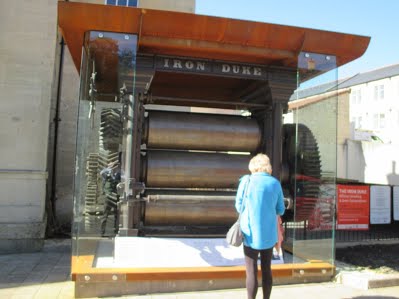
The Bridge Micky Watkins
At first there was only a ford crossing the river, hence the name Bradford. In the Norman period a stone bridge was built, and ornamented with a little chapel. The weather vane on top of the chapel is a gudgeon – a fish was an early Christian symbol. A local saying for crossing the bridge was to go “under the fish and over the water.”
The bridge was widened and lengthened in the 17th century. In 1643 there was a skirmish on the bridge, and the Royalists seized control on their way to the Battle of Lansdowne. The chapel was converted into a lock-up for the town’s miscreants. The prisoners here were provided with a loo which drained directly into the river. They were more fortunate than most 20th century prisoners, as there was no slopping-out in the bridge prison.
Post Script: shortly after our visit, traffic chaos hit Bradford on Avon, as the Town Bridge needed urgent repairs after a car ploughed into it on 3rd October, causing thousands of pounds’ worth of damage. The impact caused when a black Mercedes C180 crashed into the stonework just before 3am on Tuesday sent a three-metre chunk of the parapet hurtling into the River Avon.
Engineers from Wiltshire Council waded into the river to recover the stones, which can be re-used. It is understood the cost of repairing the Grade I listed structure could be around £10,000. (JN)
Temple of Steam Andy Simpson
Our penultimate call on the way back to London was to Swindon for the superb Steam Museum of the Great Western Railway – God’s Wonderful Railway or the Great Way Round, depending on your ‘Big Four’ pre-Nationalisation Railway Company affiliations!
Coming from Wolverhampton which once had two GWR loco sheds – one each for passenger and goods locos- plus Stafford Road Works, I’m not averse to a bit of polished brass and Brunswick Green – found here in abundance (along with a rare as hens-teeth loco works plate marked GWR Wolverhampton)
The GWR of course was the home of Brunel’s Broad Gauge – 7ft 0 ¼ inch as opposed to the standard gauge of 4ft 8 ½ inches – the Broad Gauge ended in May 1892 and relics are few, other than one original loco and three replicas. The one shown here along with a representation of the great man himself- – North Star – is a replica built by the GWR in 1925, incorporating the main driving wheels and name/works plates of the original of 1837, preserved from 1871 to 1906 then tragically scrapped ‘to save space’ at Swindon Works.
One of the first locos the visitor encounters is the magnificent 4073 “Caerphilly Castle” express passenger loco – once familiar to visitors in the splendid road and rail transport gallery at the Science Museum, South Kensington, from the 1960s through to the 1990s.
There are plenty of dioramas, signal levers to pull, loco footplates to step on and short films to watch. Swindon has had its own Railway Museum since the early 1960s, and after the tragic closure of Swindon Works by BR in 1985, part of the site was retained to house the new Steam Museum. Part of the adjacent works buildings now house a large shopping outlet – and another GWR ‘Manor’ class loco on loan from the Severn Valley Railway.
Also nearby is a major HQ building of the National Trust, and the home of the National Monuments Record.
For more details see http://www.steam-museum.org.uk/Pages/Home.aspx
https://www.historicengland.org.uk/images-books/archive
https://www.nationaltrust.org.uk/heelis
Great Coxwell Tithe Barn Vicky Baldwin
Described by William Morris as “unapproachable in its dignity, as beautiful as a cathedral, yet with no ostentation of the builder’s art” and “the finest piece of architecture in England “, Great Coxwell Barn was once part of a monastic grange owned by Beaulieu Abbey. Dating from c.1300, the walls were constructed from Cotswold rubble-stone, with ashlar blocks in the buttresses and doorways, and a Cotswold slate roof. The wooden frame supporting the roof rests on 6 pairs of stone pillars which divide the interior into 7 bays and 3 aisles. At 144ft x 38ft (43.94m x 11.63m) 5502sq ft (511 sq m) it seems enormous but is approximately half the floor area of the barn that stood at the Beaulieu St. Leonard’s home farm.
Externally, slit windows allowed for air flow rather than light, as did the putlog holes that supported scaffolding during construction. The main porched doorway is on the west (farmyard) side and, like most of the barn, shows evidence of the changes made over the centuries. In the opposite wall, facing the road, is a doorway with a smaller porch, incorporating a dovecote. The large openings in the gable ends are probably 18th Century in date.
The centre bay beyond the west porch was the threshing floor, and the pillars on either side of the east door have slots to hold the baffle board or ‘threshold’ that prevented the grain from being blown away during the threshing and winnowing processes. Crops would be delivered to the barn by the wagonload, stored, threshed, and then stored as grain either for use or (the majority) for sale.
Wagons would have drawn up to the west porch to be unloaded. Certainly the doorway appears not to have been wide enough to allow admittance, and there is a step up. As the interior of the east porch has tally marks, it is possible that grain to be sold was loaded out from there. In the upper part of the west porch there is evidence of a small chamber, possibly for the granger to oversee and supervise operations.
The security measures surrounding the processing of the harvest are evident in the following passage from a treatise of similar period:
“Give orders to your steward that your barns (graunges) everywhere are to be well secured after harvest, and that no servant or bailiff is to open them without special order or letter … until the time of threshing. And then send one of your faithful household servants who is to take with him the reeve and another faithful man. And these three men ought to be present at all times, at the opening and closing of the barns, at the threshing, the winnowing, and the transfer of the grain out of the grange – by tally – into the granary.”
Internally, the roof construction can clearly be seen. The complex system of supports, braces, beams, rafters, purlins and laths, held together with pegged joints familiar to a modern craftsman, would certainly have been interesting to William Morris. So interesting in fact, he was moved to add his name to the wealth of graffiti that adorn the walls. These are names, dates, daisy wheels (thought to be apotropaic), the interlaced ‘V’s that resemble a ‘W’ but in fact stand for ‘Virgo Virginum’, the ‘M’ for ‘Maria’, preparatory marks for further embellishment, and tally marks. It is not just time that has left its mark on the barn.
(Quotation on crop and barn security copied from the 1996 NT leaflet about the barn).
OTHER SOCIETIES’ EVENTS compiled by Eric Morgan
Wednesday 8th March, 6 pm Gresham College at Museum of London, 150 London Wall EC2Y 5HN. The Value of Heritage and the Heritage of Value. Simon Thurley. Free.
Friday 10th March, 7.45 pm, Enfield Archaeological Society, Jubilee Hall, 2 Parsonage Lane, junction of Chase Side, Enfield EN2 OAJ. The Must Farm Archaeological Project. Talk by Mark Knight, visitors £1. Refreshments, sales and information from 7.30 pm.
Thursday 23rd March, 6pm, Gresham College, Barnard’s Inn Hall, Holborn EC1N 2HH. The Rise and Fall of Sourdough – 6,000 Years of Bread. Fullbright Lecture, given by Professor Eric Pallant. (Covering food history of the Western World). Free.
Friday 7th April, 7.45 pm, Enfield Archaeological Society, Jubilee Hall, 2 Parsonage Lane, junction of Chase Side, Enfield EN2 OAJ. E.A.S. Fieldwork in 2016. Church House, Wood Street, Barnet (opp. Museum). Talk by Martin Bearne, preceded by AGM. Visitors £1.
Monday 10th April, 3 pm. Barnet Museum & Local History Society. Church House, Wood Street (opposite Museum). Hadrian’s Wall and Life on Rome’s Northern Frontier. Talk by Matthew Symonds. Visitors £2.
Wednesday 19th April, 7.30 pm, Willesden Local History Society, St Mary’s Church Hall, Neasden, NW10 2TS (nr. Magistrates’ Court). George Furness – Willesden’s Greatest Resident. Talk by Margaret Pratt and Cliff Wadsworth on one of Willesden’s greatest Victorians, running the local brickworks, building houses, roads and sewerage.
Wednesday 26th April, 7.45 pm, Friern Barnet & District Local History Society, North Middx. Golf Club, The Manor House, Friern Barnet Lane, N20 ONL. The Hunting of Hepzibah – a Family History with a Twist. Talk by Jim Nelhams (HADAS) £2.
Thursday 27th April, 8pm, Finchley Society, drawing room, Avenue House (Stephens’), 17 East End Road, N3 3QE. The Regent’s Canal (and Museum) by Roger Squires. £2.
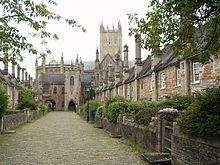 Number 551 FEBRUARY 2017 Edited by Andy Simpson
Number 551 FEBRUARY 2017 Edited by Andy Simpson
HADAS DIARY – LECTURE PROGRAMME 2017
Tuesday 14th February 2017; London Ceramics at the time of the Great Fire, by Jacqui Pearce
Tuesday 14th March 2017; Bugging the Nazis in WW2; Trent Park’s Secret History, by Helen Fry
Tuesday 11th April 2017; To Be Confirmed
Tuesday 9th May 2017; The Cheapside Hoard, by Hazel Forsyth
Tuesday 13th June 2017; ANNUAL GENERAL MEETING
Tuesday 10th October 2017; The Curtain Playhouse Excavations, by Heather
Knight, MOLA
Tuesday 14th November 2017; The Battle of Barnet Project, by Sam Wilson
Lectures are held at Avenue House, 17 East End Road, Finchley, N3 3QE, and start promptly at 8 pm, with coffee/tea and biscuits afterwards. Non-members: £1. Buses 82, 125, 143, 326 & 460 pass nearby and Finchley Central station (Northern Line), is a 5-10 minute walk away.
Post-Excavation Work – Medieval Cricklewood! Andy Simpson
As ever, Sunday Mornings at Avenue (Stephens) House continue in the usual vein with the ‘usual suspects’. Good work is again being done on the Clitterhouse Farm 2016 (site code CTH 16) excavation finds analysis, with all finds now washed and marked. The bulk finds sheets have also been completed. More medieval pottery has been identified from across the site, to supplement the three sherds of southHertfordshire type grey Ware (MOLA fabric code SHER, 1170-1350) found in 2015, including a body sherd of SHER and two body sherds of early south-Hertfordshire type coarse ware (ESHER) dated 1050-1200 – our first potential Conquest period pottery from the site.
Contemporary with these is a single small body sherd of early medieval coarse sand- tempered ware (EMCS, 1050-1200)
There is also a single body sherd of late medieval Hertfordshire glazed ware (LMHG, 1340- 1450). All of the 2016 medieval pottery is from disturbed residual contexts, unlike the SHER found in 2015 in a presumed primary ditch fill.
This is an exciting development pushing back the known chronology of the site.
Footpads Talk: A Reflection on Finchley Common robberies. Simon Williams
Simon adds some more local details following on from the report on the talk on footpads in South London by Margarette Lincoln in the January newsletter.
At its peak, Finchley Common was 5.0 km2; by enclosure (1816) it was reduced to 3.6km2; of mostly woodland—comprising Copetts Wood, Coldfall Wood & The Glebelands; it sprawled from East Finchley to Barnet.
The famous clown ‘Joey’ Joseph Grimaldi 1778-1837 (who single-handedly revolutionised the clown from the Shakespearean rustic buffoon to the version we recognise today: inventing face-paint, bright clothes, the pantomime catchphrase, combined with it’s star-act/pop personality- association, his one-time ‘Hot Codlins’ fame) was robbed on Finchley Common c.1800; he lived near the present Finchley Memorial Hospital. The Earl of Minto stated to his wife that he would not, “trust my throat on Finchley Common in the dark”. Edmund Burke MP was also a victim in 1774. Villains associated with the Common include Jack Shepard, Dick Turpin & the “Wicked Lady’s” lover (he was caught there).
Less famous were ‘Everett & Williams’ who went as far as to draw up a legally witnessed contract that they would split their plunder after a year’s work in 1725.Gibbets were in use here from at least the 1670’s, another was at Tally-Ho Corner.
A combination of the Enclosure Act, paper money which in 1797 was easily traceable (presumably because there wasn’t much in personal circulation?), together with the opening of the first bank in 1692 meant that travellers to London no longer carried huge amounts of gold on them.
The Bow Street Horse Patrol policed from Highgate to Barnet between 1805-51; was it finally stopped due to reduced traffic?- in the advent of the railway boom?
These possibly conspired to put the robbers out of business? As one looks at the bleak unforgiving municipal streets of Barnet today, albeit no Sylvan Idyll, we are all probably better- off?!
Bradford on Avon – Day 4 Jim Nelhams
Thursday started with a stop in the market town of Frome, from whence we moved on to Wells. It seemed that few of our group had visited Frome before, and although a number had been to Wells, few had visited the Bishop’s Palace. We started in Frome at the parish church on a hill above the town centre before making our way down Cheap Street to the Museum, yet another important organisation run entirely by volunteers.
St John the Baptist Church, Frome Dudley Miles
The original church was built in 685 by Aldhelm, Bishop of Sherborne and a leading Anglo-Saxon scholar. Virtually nothing survives of his church, and it was remodelled on several occasions, most notably in the thirteenth century, and in the Victorian period, when it had fallen into a derelict state and much of it was rebuilt by the controversial Anglo-Catholic priest, W. J. E. Bennett.
The Lady Chapel dates back to Norman times and has a Saxon window, as well as ten windows by the leading Victorian stained glass designer, Charles Kempe. Another survival is St Nicholas Chapel, now the baptistery, which dates to 1408 and has a fine thirteenth-century font.
Several of us were fascinated by two Saxon stones. The upper one, which dates to the eighth century, is part of a vertical shaft of a cross, while the lower one, which is ninth century, is a carving of an animal. Sadly, there is no evidence that the stones were part of the Anglo-Saxon church.
A unique feature is the nineteenth-century Via Crucis or Way of the Cross, a set of statues illustrating Christ’s road to Calvary on a processional way up the steps to the church. Unfortunately, the gate from the street to the processional way is now locked.
Cheap Street, Frome Beverley Perkins
Down the hill from the St John’s Church lies Cheap Street, the original shopping street of Frome (from the Saxon name for barter – ceap). Frome was granted a charter for a market in 1239 and the street itself dates from that period. However, the existing buildings were mainly constructed in the 1500s and, following a fire, in the 1830s. Although some half-timbered buildings with jettied upper storeys remain, the origins of most are disguised by more recent frontages and by modern shop windows at ground floor level. No. 11 Cheap Street, a Tudor house with overhanging jetties and massive beams carved with rosettes, is the oldest house in Frome. A narrow rivulet runs down the centre of the cobbled street – picturesque, but a hazard for walkers!
Frome is known for its Cockey lamps, unique to Frome and made in art nouveau style by local company Edward Cockey & Sons. Originally made for gas, they were later converted to electricity. One of these lamps spans Cheap Street in an elegant arch. For more information see https://fromemuseum.wordpress.com/collection/metalworking/cockey and for photographs see www.frometowncouncil.gov.uk/wp-content/uploads/2016/06/FromeCockey-Lamps-2016.pdf.
Frome Museum Claudette Carlton
Frome Museum is situated in a Georgian house. At present the Museum is located on the ground floor, but there are plans to extend to the upper floor of the building next year.
There is a very elegant staircase connecting the floors of the house.
The group was welcomed by Emma and David Robinson, members of HADAS, who, although resident in Colindale, spend a lot of their time in Frome. Emma is Chair of the Trustees of the Museum. Tea, coffee and very good cake were provided for the group, for which many thanks.
There is a fascinating cabinet of curiosities in the museum, pictorial records of the casting of bronzes in the Singer foundry in Frome, including that of Boudicca/ Boudicia, which now stands on the Thames Embankment and of Sheppards Mills, a textiles mill sited in Spring Gardens Frome. In its heyday children as young as 7 years worked there, 6am to 7pm, Monday to Friday, and up to 2pm on Saturday. The mill closed in 1878.
There was also a display of the record of one local man’s service in the Great War, his medals and other memorabilia; and another about Siegfried Sassoon, some of his poems, and a brief account of his life.
Many thanks to HADAS for allowing me to do this trip, and to the group for their good company.
Bishop’s Palace, Wells Ken Sutherland Thomas
On arrival in Wells, we were presented with a wealth of historic sites to visit including the Bishop’s Palace and the Cathedral.
On entering the Palace grounds and skirting the appealing coffee shop, I planned firstly to explore the gardens and to enjoy the views from the walkway on the ramparts. The Palace has been the home of the Bishops of Bath and Wells for over 800 years.
The gardens are about 14 acres in extent and include a number of pools (where the original wells were in times past the fresh water source for the local population).
Some of the pools afford wonderful reflections of Wells Cathedral.
I did not have time to explore the Arboretum which is also part of the grounds. With the time limited, I joined a group of visitors for a tour of the Palace buildings open to the public.
The Palace partly dates from the 13th century and work commenced on it when Bishop Joselin Trotman received a Royal licence to build a residence and Deer Park on land to the south of Wells Cathedral, St Andrews.
Our guide took us into the vaulted undercroft and then up an impressive staircase to what in past times would be the rooms where the Bishop ate and slept as well as entertained. We viewed the large gallery with many paintings of past Bishops as well as other artefacts.
Exiting the Palace, time allowed for a short visit to the ruins of the Great Hall. Built in 1290 for Bishop Burnell, the remains are the most impressive example of a Medieval open hall. It was built in Early English Decorative style. The remaining large windows frame beautiful views of the Cathedral.
Leaving the Palace grounds, I briefly joined many other visitors hoping to see the Wells Swans on the moat around the Palace. The swans are renowned for ringing a bell when it is feeding time.
Wells Cathedral Frances Radford
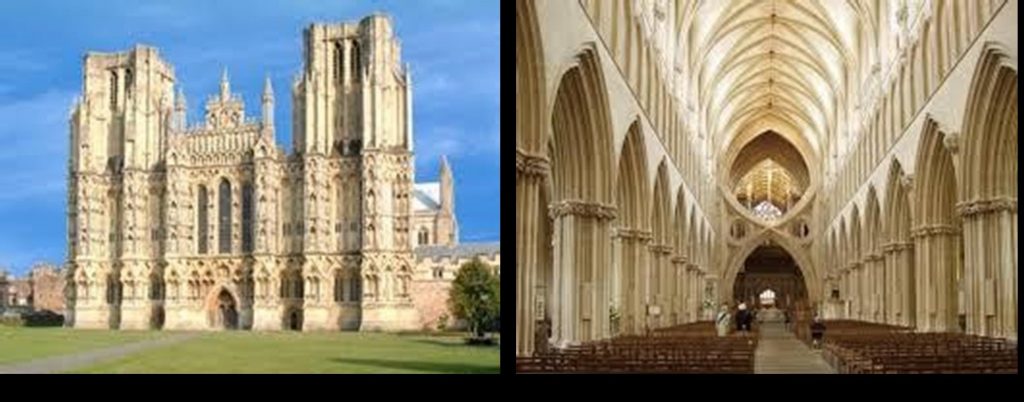 Wells is one of the most memorable of English Cathedrals due externally to the grandeur of the West Walls and internally to the unique scissor like structure which dominates the view from the nave.
Wells is one of the most memorable of English Cathedrals due externally to the grandeur of the West Walls and internally to the unique scissor like structure which dominates the view from the nave.
The façade of the West Front presents as a giant screen intended for a display of statuary. The great breadth of the front is emphasised by two string courses which define three horizontal zones countered by the verticals of the buttresses.
The lowest section contained scenes from both Old and New Testaments. Above this, statues of knights and ladies, kings and queens, bishops and saints and above them a row of the twelve disciples. At the top, centrally placed, a figure of Christ in Majesty. St Andrew, the patron saint of the cathedral is represented.
Many figures were damaged or disappeared later, but in their original state were, no doubt, intended to educate and impress the public, underlining the importance of the Cathedral and the Christian religion. It must have been particularly impressive when the west front was painted in bright colours or red, blue and green, providing a dramatic background for religious processions such as on Palm Sunday.
The first thing that strikes you as you arrive in the nave is the extraordinary scissorlike structure at the entrance to the quire, built 1338. The pale colour of the stonework plus the unusual shape gives, at first glance, a modern feel to the building. Its pointed arch fits well with the Gothic arches in the nave, making it part of the whole. The scissor arches were erected on three sides of the crossing in order to support the tower, as it had begun to crack and lean. One cannot help but be amazed at the ingenuity and skill of these early builders – (without all our modern technology).
The great Jesse Window above the high altar shows Christ’s family tree from the beginning with Jesse, the father of King David. In the Lady Chapel, there are more windows of note, four out of five of which are completely composed of fragments of ancient glass rescued after the destruction the Cathedral suffered as the result of the Civil War (1662-7) and the Monmouth Rebellion (1685). These jumbled fragments assembled together have made very beautiful windows.
The Lady Chapel is an elongated octagon but open westwards so is not separate from the body of the Cathedral. The floor has an intricate pattern of Victorian style tiles in black, cream and terracotta, while above, the ribs of the vault become a central star, painted as a copy of the original decoration.
Outside this chapel is a tall brass lectern inscribed to Dr Robert Creyghton who returned after fifteen years’ exile. “His Sovereign Lord King Charles II made him Dean of Wells in 1660” and gave the lectern to the Cathedral.
The misericords, beautifully carved, and the carvings on the capitals and corbel stones give a picture of life at the workers’ level; man with toothache, man removing a thorn from his foot, trout stealers being beaten, and a sleeping cat: also the headstone said to be of master craftsman Adam Lock.
Alas, due to shortage of time, many other treasures were missed including the Chapter House.
P.S. Quote from The Cathedrals of England by Alec Clifton-Taylor (architectural historian and critic) re scissor structure…
“Although their mason-craft is much more agreeable than modern concrete, in their audacity, even starkness, they carry analogies with certain contemporary structures, especially bridges, in that material.
Accordingly, there are those who wax enthusiastic about the strainer arches of Wells; but the plain truth can only be that in a building so exquisitely detailed, so abounding in subtleties, they are a grotesque intrusion” What do you think?
Vicars’ Close Katie McGrath
Vicars Choral, the men who sing in the choir at Wells Cathedral, have been established since 1140. In 1348 they were incorporated as a College of Vicars when the dining hall above the archway leading into the close came into use. This allowed them to transact their business and eat communally. The houses were completed by 1363. Originally there were 42 small houses forming a quadrangle with a chapel for the vicars at the far end, above which was their Library. In 1466 further alterations were made and the chimneys were raised and crowned with tall decorative octagonal stacks. Round about this time a Chain Bridge was built to link Vicars’ Hall with the Cathedral, and gardens were introduced. Following the Reformation in the 15th century the number of vicars was reduced and they were allowed to marry, so the houses were put together to form larger dwellings and Vicars’ Close took on its present appearance. Today, together with the choristers, the Vicars Choral sing services every day in term time. They still live in the Close, as do other members of the Cathedral foundation, including the Organist and Master of the Choristers. Altogether Vicars’ Close is an exceptional group of buildings and forms an important part of the whole Cathedral complex.
It is claimed to be the oldest purely residential street with original buildings surviving intact in Europe.
January Lecture Report – My Uncle, the Battle of Britain VC
by James Nicolson Lecture Report by Andy Simpson
A small group of HADAS members and visitors enjoyed this most informative talk.
The first-born son of the Nicolson family is traditionally called James. Our speaker continues the tradition with the eldest of his two sons. However, just to confuse matters, the subject of the talk – Wing Commander Eric James Brindley Nicolson VC DFC (29 April 1917 – 2 May 1945) was christened Eric, called Nick in the RAF, and
Bill by his family! Of some 150,000 aircrew on wartime ops in the RAF (of whom 55,000 died in Bomber Command alone), just 26 were awarded Britain’s highest military gallantry award, the Victoria Cross (VC), with Nicolson the only Fighter Command Recipient.
Nicolson was born at 38 Crediton Hill, Hampstead, living there until aged seven when the family moved to Shoreham, West Sussex. Always keen on joining the RAF, an initial attempt was unsuccessful so he joined a local engineering firm and became a keen amateur cricketer. Being 6ft 3ins tall he was a good bowler. He joined the RAF in October 1936, being posted to RAF Church Fenton in Yorkshire, flying Gloster Gladiator biplane Fighters with No. 72 Squadron. As Section Leader of three, his particular aircraft was serial number K6140. He became an accomplished display pilot, even broadcasting to the crowd during the 1939 air display. He and his fellow squadron members led a typically high-spirited off-duty life, racing their MG sports cars in reverse around the airfield!
He was careful however to give his ground crew five Players cigarettes each every Friday morning. The then standard battle formation of a ‘vic’ of three aircraft was too rigid. The two wingmen were meant to closely follow the leader and fire their four Browning machine guns each on his lead, concentrating so hard on keeping formation and not colliding with one another that they had little time to detect incoming attacking fighters. The Germans, with their much looser formations based on a ‘rotte’ (pair), even coined the term ‘row of idiots’ for this formation.
The 72 Squadron aircraft swapped all-over silver for hastily-applied camouflage at the time of the Munich Crisis in 1938. A telling group photo of Nicolson and his six Squadron chums at this time led to the recounting of the final toll – two badly burnt, two killed and two otherwise wounded. At this time he also met a farmers’ daughter from Tadcaster –Muriel, 13 years his senior. She was reluctant at first due to the age gap, but in July 1939 they commenced a happy marriage.
The VC was presented during an informal chat with the King at Buckingham Palace, his wife being allowed to attend also. Nicolson felt awkward and was ordered to wear his medal ribbon, which he usually hid by wearing an overcoat.
Fully recovered by September 1941 and keen to get back to flying, Nicolson was posted to India in 1942. Between August 1943 and August 1944 he was a Squadron Leader and C.O. of No 27 Squadron, flying Bristol Beaufighters over Burma, being very successfully teamed with his navigator and gaining the DFC and an old-beforehis-time look in photographs. During this time he was awarded the Distinguished Flying Cross and was involved with two squadron mascots – young bear cubs who rather outgrew their welcome. One was shot and the other eventually parachuted out over the jungle from a Dakota after he persistently returned to base!
As a Wing Commander, he was killed on 2 May 1945 when a RAF B-24 Liberator
‘R-Robert’ from No. 355 Squadron, in which he was flying as an observer for a bombing raid on Rangoon, caught fire and crashed into the Bay of Bengal after two engines failed.
Although he was one of four of the crew of ten who made it into a dinghy after ditching and were eventually found by a Catalina flying boat, he sadly drowned and his body was not recovered. He is commemorated on the Singapore Memorial.
Muriel Nicolson received the telegram informing her of his death on 8 May 1945 – VE Day. He left an estate of just £212, leaving Muriel in financial hardship; their son won a scholarship to Rugby School. She never remarried, living to over 100, and eventually sold his medals for £110,000 in 1983 – then a world record. They are now held by the RAF Museum at Hendon. The RAF Museum also holds Spitfire Mk 1 K9942 (at RAFM Cosford) flown by Nicolson with 72 Squadron in 1939-40.
An RAF VC-10 transport carried his name in the 1970s/80s and a Battle of Britain Memorial flight Hurricane carried the markings of his Hurricane for a while, along with a RAF Eurofighter Typhoon fighter for the 2016 display season.
Other Societies’ Events Eric Morgan
Thursday 16th February, 7.30pm Camden History Society Burgh House, New End Sq, NW3 1LT. Played in Camden – The Sporting & Recreational Heritage of a Borough at Play. Talk by Simon Inglis. Visitors £1.
Friday 17th February, 7.30pm; Wembley History Society English Martyrs Hall
Chalk Hill Road Wembley HA9 9EW (Top of Blackbird Hill, Adj. to Church) A Tour of Elizabethan London Talk by Nick Dobson Visitors £3. Refreshments available.
Thursday 23rd February 2.30pm Finchley Society Drawing Room, Avenue House
(Stephens House) 17 East End Road N3 3QE- Investigating our Local Community – Talk by Archer Academy Year 7 Students and Air Pollution Survey of North Finchley Talk by Chris Church Non-members £2 . Refreshments available.
Thursday 2 March 8pm Pinner Local History Society Village Hall, Chapel Lane Car Park, Pinner. Pinner’s Grand Houses & the People who Lived in Them – Presentation by Research Group – New Research by Society Members . Visitors £2.
Wednesday 8th March , 2.30pm Mill Hill Historical Society Trinity Church, The Broadway, NW7. Hidden Rivers at Stanmore Marshes Vicki D’Souza & AGM.
Wednesday 8th March, 7.45pm Hornsey Historical Society Union Church Hall, Corner Ferme Park Road /Weston Park N8 9PX Tottenham’s Forgotten Houses Talk by Val Crosby Visitors £2 Refreshments, Sales & Info from 730pm.
Monday 13th March, 3pm Barnet Museum & Local History Society Church House, Wood St, Barnet (Opp. Museum) The Jesus Hospital Almshouses Talk by Yasmine Webb. Visitors £2.
Wednesday 15th March, 7.30pm Willesden Local History Society St Mary’s Church Hall, Neasden Lane, NW10 2TS (Nr. Magistrates’ Court) The London Welsh School Talk by Elinor Delaney about its history and current activities in Willesden & Stonebridge.
Thursday 16 March, 8pm Historical Association; Hampstead & NW London Branch Fellowship House, 130A Willifield Way NW11 6YD (Off Finchley Rd in Temple Fortune) The First World War & The Middle East. Talk by Paula Kitching.
Saturday 18th March, 11am – 5.30pm LAMAS Archaeology Conference Weston Theatre Museum of London London Wall EC2Y 5HN Morning session – recent work. Afternoon session – talks on the Crossrail Project. Displays of work and publications. Cheque/PO payable to LAMAS plus SAE to Jon Cotton, Early Dept, Museum of London 150 London Wall EC2Y 5HN. See website www.Lamas.org.uk
Wednesday 22nd March, 7.45pm Friern Barnet & District Local History Society,
North Middx Golf Club, The Manor House, Friern Barnet Lane N20 0NL. East
Barnet- 100 Years of History. Talk by Richard Elby Visitors £2. Refreshments & bar
Friday 24th March, 7.30pm Wembley History Society English Martyrs’ Hall, Chalk
Hill Rd, Wembley HA9 9EW. Forgotten History of Kingsbury & Hendon Project – Part II Talk by J H Moher, continuing the story of our local Aircraft & Engineering Trades. Visitors £3. Refreshments in interval 50p.
Monday 27th March, 8pm Harefield History Society Park Lane Village Centre, Park
Lane, Harefield Middx Alice, Countess Dowager of Derby & Harefield; Myths,
Marriages & Milton. Talk by Prof. James Knowlee. (And also Monday 27th
FEBRUARY 8pm The Great Barn at Harmondsworth- Past, Present and Future Talk by Justine Bayley)
Thursday 30th March, 8pm Finchley Society Avenue House, East End Road N3 3QE Drawing Room. From Spare Bedroom to Woodside Park – The Early Years of the North London Hospice Talk by Harriet Copperman O.B.E. Non-members £2.
STOP PRESS! CURRENT ARCHAEOLOGY LIVE CONFERENCE 24-25
FEB; Subscriber rate £99, non-subscriber £139; See
With big thanks to this month’s contributors;
Eric Morgan; Simon Williams and Jim Nelhams and the Wiltshire trip reporting team: Claudette Carlton; Katie McGrath; Dudley Miles; Beverley Perkins; Frances Radford and Ken Sutherland Thomas.
No. 550 JANUARY 2017 Edited by Sue Willetts
We would like to take this opportunity to wish all our readers a Happy and Prosperous New Year.
HADAS Diary
Tuesday 10th January 2017: My Uncle, the Battle of Britain VC, by James Nicolson
Tuesday 14th February 2017: London Ceramics at time of the Great Fire, by Jacqui Pearce
Tuesday 14th March 2017: Bugging the Nazis in WW2: Trent Park’s Secret History, by Helen Fry
Tuesday 11th April 2017: to be confirmed
Tuesday 9th May 2017: The Cheapside Hoard by Hazel Forsyth
Tuesday 13th June 2017: ANNUAL GENERAL MEETING
Tuesday 10th October 2017: The Curtain Playhouse Excavations, by Heather Knight, MOLA
Tuesday 14th November 2017: The Battle of Barnet Project, by Sam Wilson
Lectures start at 7.45 for 8.00pm in the Drawing Room, Avenue House, 17 East End Road, Finchley N3 3QE. Buses 82, 143, 326 & 460 pass close by, and
it is five to ten minutes’ walk from Finchley Central Station (Northern Line). Tea/coffee and biscuits follow the talk.
HADAS Christmas Party Don Cooper
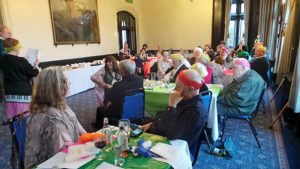 34 people assembled at Avenue House on Sunday 11th December for our annual Christmas event and a good time was had by all. This time not a buffet, but a sit-down meal preceded by canapes prepared and served by Malcolm and his staff. The tables were adorned with coloured table cloths and crackers and party poppers.
34 people assembled at Avenue House on Sunday 11th December for our annual Christmas event and a good time was had by all. This time not a buffet, but a sit-down meal preceded by canapes prepared and served by Malcolm and his staff. The tables were adorned with coloured table cloths and crackers and party poppers.
Table quizzes to check our knowledge were devised by Vicki Baldwin encouraging much cerebral exercise.
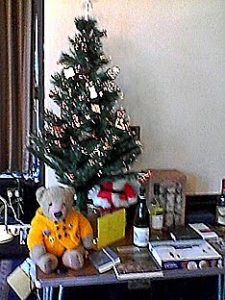 Musical entertainment was performed by Jo and Jim Nelhams and Andrew and Liz Tucker, and visual entertainment from Don Cooper sporting this year’s Christmas jumper and hat.
Musical entertainment was performed by Jo and Jim Nelhams and Andrew and Liz Tucker, and visual entertainment from Don Cooper sporting this year’s Christmas jumper and hat.
There was also a successful raffle – see photo for the great prizes. No Ted, of course, as he is the HADAS mascot. The food was concluded with tea / coffee and mince pies, and two splendid cakes, one fruit and one sponge both cooked by Liz Gapp.
Lovely to see two newer members, Annette Bruce and Joanna Fryer attending this event for the first time. Huge thanks to everybody who helped with the organisation.
London and Middlesex Archaeological Society, Walking through London’s History. 51st Local History conference – at Museum of London 19.11.2016 – short report.
The first presentation was from Prof. Caroline Barron and Prof. Vanessa Harding on Mapping Medieval and Early Modern London. They are working on a project to update the Historic Towns Trust’s map of London, c.1520 and they described the sources available to them. The HTT’s map appears in Mary Lobel’s 1989 book The City of London from Historic Times to c.1520 which needs correction and updating. They will use digital enhancement techniques and will include information from archaeological sources. NB It is not yet available so watch for an announcement in the near future. Below are abstracts from two more presentations – a fuller report appears in the LAMAS Newsletter Issue 149, January 2017.
A Footpad’s View of South London in the late Eighteenth Century – talk by Margarette Lincoln
This talk took us through the night-time, criminal activity along two major roads in South London which linked central London with naval dockyards and the continent. It focused on the last quarter of the eighteenth century, which experienced several notable crime waves, and considered whether the nature of highway robbery on one road was discernibly different from that committed on the other, looking at the impact of key taverns, local turnpikes and nearby convict hulks moored along the river. These all formed part of the local landscape for roadway travellers. Rampant street crime affected different social networks and both formal and informal steps were taken to police these two routes, with mixed results. The talk also considered how different crimes were reported in the newspapers: there were specifics that would help travellers to take precautions. Finally, the talk considered the effect that both routes had on the reputation of their localities (which can still be traced today), and therefore the legacy of eighteenth-century ‘walking’ for present Londoners.
Dr Margarette Lincoln is a Visiting Research Fellow at Goldsmiths, University of London, and Curator Emeritus at the National Maritime Museum, Greenwich, London, where she was Deputy Director from 2007 to 2015. Most recently, she edited the catalogue for the Museum’s special exhibition, Samuel Pepys: Plague, Fire, Revolution (2015). She is currently working on a book about eighteenth-century maritime London.
Paying for Passage: the impact of tolls on the 19th century London pedestrian – talk by Simon Morris
Pedestrians in London walked the streets for free, unless they happened to be using a tolled road or bridge. The first half of the 19th century saw the construction of a number of privately financed roads and bridges, many of which – unlike the regular bridges and turnpikes – charged not only carts and carriages, but also pedestrians for the right of passage. These bridges included major central crossings such as Waterloo, Southwark and Lambeth Bridges as well as suburban bridges such as Hammersmith, Battersea, Wandsworth and Deptford Creek. The only road on which a foot toll was charged was Highgate Archway, although Barking Road was interrupted by a toll bridge across the River Lea. This talk described where and why these roads and bridges were constructed, and the growing tension arising from their being built to create communication yet obstructing passage by erecting barriers and charging tolls. It also touched on the adverse social impact that a foot toll might cause, for example hindering poorer citizens wanting to cross the river to enjoy the newly opened Battersea Park, and also depressing the development of new housing in the neighbourhood. There was a growing campaign for the abolition of these tolls which, after many struggles, succeeded in the early 1880s.
Simon Morris is a member of the Council of the London Topographical Society and has a particular interest in the development and mapping of London; he is currently researching 19th century street signs. Simon studied law at Cambridge University and History at London University.
London Archaeological Prize 2016 and HADAS Don Cooper
The winners of this prestigious biennial prize were announced at the London Archaeological Forum on Monday 28th November 2016. There were nine publications on the shortlist.
The winner was “Temples and Suburbs, Excavations at Tabard Square, Southwark” by principle author Dougie Killock with John Shepherd, James Gerrard, Kevin Hayward, Kevin Rielley and Victoria Ridgeway published by PCA in 2015. It is available from Oxbow Books for £27
Second was “Roman Sculpture from London and the South-East, CSIR (Corpus Signorum Imperii Romani) Volume 1, Fascicule 10” by Penny Combe, Francis Grew, Kevin Heyward and Martin Henig, published by the British Academy and Oxford University Press. It is available from OUP for £120.
There were three publications cited with honourable mentions including: “A Hamlet in Hendon” by the HADAS Finds Group, published by HADAS in 2014. It is available from HADAS
(chairman@hadas.org.uk) for £20 plus p&p. The judge’s comment: This is an important book for Hendon and has obviously been the work of many years for the members of the society. It is a great achievement and covers a lot of material which will be of use and interest for many years to come.
A Generous Donation
HADAS has received a cheque for £100 from Dr Ann Saunders MBE to be put towards the cost of our next publication. Ann was president of HADAS from 1998 to 2001 and is a long-time influential member. We thank Ann for her generous donation and wish her well for the future.
BRADFORD Trip – Day 3 Jim Nelhams
Bradford on Avon – Day 3 Jim Nelhams
After an energetic day in Bristol, time to let the feet recover and let motors take the strain. Jo and I first encountered Bradford on Avon when we passed through on a narrowboat on the Kennet and Avon Canal. Our canal map showed a tithe barn next to the canal, so we went to investigate, and then looked round the town. It was on the same trip that we found Claverton, our second point of interest for the day. Time now for a second look. Our coach took us to the far end of the station car park from where a footpath leads along the river bank to the barn. Then from Bradford to Bath.
The Tithe Barn, Bradford-on-Avon David Bromley
This impressive Grade 1 listed barn was built in the 14th century and was part of the medieval grange belonging to the nuns of Shaftesbury Abbey until its dissolution in 1539, when it then became a private farm until 1974. It forms part of a farm complex and dominates the farm yard. It is of fine cut ashlar masonry, double-skinned with a rubble fill and measuring 51 meters long by 10 wide. The side walls are 0.75m thick, the gable ends are 0.9m and have 4 external buttresses, two corner and two central.
Running roughly east-west, the roof is high pitched with stone tiles and projecting eaves. These tiles are hard limestone graded in size, getting smaller as they rise up the roof. Each is drilled and pegged with oak pins hooked over split oak battens. The estimated roof weight is 100 tons.
There are 14 bays divided by 13 trusses. Bays 5 and 10 form the porches which are larger on the north side to enable unloading of the wagons. These porches also provide a cross-draught needed for winnowing the corn. The thirteen crucks are individual pairs, each set on a stone foot, all at different heights. This was to make best use of local timber. Two are true single-tier crucks and the other 11 are two-tier crucks. Each truss is made up of about 100 cubic feet of English oak and weighs about 3 tons.
There are three tiers of wind-braces. The roof timbers have been dated between 1334 and 1379.
Each of the cruck frames has an external buttress built into the wall for added strength. Two of these, at the front west end, have been cut back to allow clearance for a horse engine, a beam pulled by a horse and connected via a shaft and gear to machinery inside the barn (chaff cutter or turnip chopper etc.). The roof was extensively repaired by the Ministry of Works in the 1950s.
Canal Trip from Bath to Claverton Pumping Station Liz Tucker
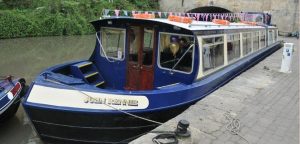 Whenever I go to Bath, I always imagine myself wearing a poke bonnet and a Regency style gown, in a Jane Austen costume drama. “It is a truth universally acknowledged” that this author wrote mainly about human relationships, ignoring events in the wider world during her lifetime. In fact, in her novels you can find references to naval battles and to the slave trade – but I cannot find any mention of the Kennet and Avon Canal, opened in 1810.
Whenever I go to Bath, I always imagine myself wearing a poke bonnet and a Regency style gown, in a Jane Austen costume drama. “It is a truth universally acknowledged” that this author wrote mainly about human relationships, ignoring events in the wider world during her lifetime. In fact, in her novels you can find references to naval battles and to the slave trade – but I cannot find any mention of the Kennet and Avon Canal, opened in 1810.
Starting at Bathwick, to avoid any locks, we glided along the canal for about three miles. We set off in an elegant, oak-panelled boat, called “The John Rennie” after the canal’s designer, who was responsible for numerous British canals and bridges. A broad beam boat, it only just got through a couple of short tunnels, sometimes bumping the sides. We saw five bridges, one a swing bridge; the first buildings we saw were halfway, at the small village of Bathampton, built of the Bath stone which was quarried locally.
After we rounded a bend, the scenery became more hilly. At last we reached the Claverton Pumping Station (to be described separately). This opened in 1813, for the purpose of topping up the canal when it lost water through the locks, or by leakage.
On the return journey we enjoyed a cream tea, while observing the various colourful boats, some with comical names such as “My Newt”, or with monkeys as figureheads. After two busy days, it made a nice change to sit and relax on a boat. It also made an interesting change to see a construction that was not by Brunel!
Claverton Pumping Station Stewart Wild
We disembarked from our canal boat right onto the canal bank and towpath. Then it was a short walk to reach the little lane that led downhill to cross the railway line – Stop, Look and Listen – and reach the old pumping station alongside a leat off the River Avon.
When this part of the K&A Canal was completed in 1810, under brilliant Scottish engineer John Rennie (1761–1821), it was necessary to overcome water supply problems. Fortunately at Claverton there was a convenient site close to the canal and alongside the Avon that had housed a water-powered corn mill. Rennie got his men to rebuild the mill and convert it to a powerful pump house, and it was working by 1813, supplying fresh water to the canal to replace that lost to leakage, evaporation and the operation of locks.
We split into small groups, each with a guide, to ease our way through the confined spaces in the 200-yearold building, which is Grade II listed. We admired the huge 24ft-wide wooden breastshot water wheel, over 17ft in diameter. When the sluices are opened, the wheel was designed to permit two tons of water each second to flow onto 48 wooden slats and propel it through one revolution every twelve seconds. Through gears and couplings, this energy translates to drive the vertical con rods powering the engine’s two cast-iron rocking beams, each weighing five tons, which in turn drive the 18-inch pistons of the lift pumps.
Since 1952 the power to the pumps has been provided by diesel-powered electric motors, which can pump up to 100,000 gallons per hour to top up the canal above. Rennie’s machinery had coped continuously until that year when much damage was caused by a floating log which trapped itself in the waterwheel. The problem may have been made worse by a lack of maintenance which until then had been the responsibility of GWR staff based at the Swindon works.
Then for fifteen years this lovely gem of industrial archaeology was left abandoned and derelict (by this time the lack of canal traffic meant little need for top-up water). However in the 1960s and 1970s restoration was carried out by students from the University of Bath under the supervision of the Kennet and Avon Canal Trust who replaced and repaired the buildings and equipment and returned the pumping station to a functional state by 1977.
From 1978 to 2012 the waterwheel and all other wooden parts and gears were replaced and rebuilt using Douglas fir from Scotland, and we should have seen it all in operation. Unfortunately there had been a few technical problems, but by the time you read this it should all be working well again, thanks to a dedicated band of the Trust’s volunteer engineers, some of whom have put in more than thirty years’ service.
Later the friendly guides showed us their upstairs workshop and mess-room, complete with original cosy Victorian range and hearth – we would have liked to have stayed longer to chat. Our thanks to them all for a most enjoyable and informative visit.
Archaeology in Hertfordshire: Recent Research, Ed. Kris Lockyear, Hertfordshire
Publications, 2015. Review by Bill Bass
“A Festschrift for Tony Rook” is the sub-title, Tony has been involved for many years in the archaeology of Hertfordshire as the Director of Welwyn Archaeological Society and has many publications behind him. This book is based on a conference to mark his 80th birthday in 2012.
The first couple of chapters puts the archaeology of Hertfordshire in context together with a potted history of the Welwyn Archaeological Society. Early papers include settlement and landscape from 1500BC – 300BC, much work has been undertaken since 1993. ‘The Baldock Bowl’ a Neolithic and early Bronze-age landscape area to the east of Letchworth is highlighted for its focus and use.
‘When was the Roman Conquest in Hertfordshire?’ The author here (Isobel Thompson) discusses the ‘transition’ of iron-age control to Roman administration. Further papers deal with the survey of Roman coins and hoards through archaeology. Continuing the ‘Romanisation’ theme Simon West (District Archaeologist) looks at recent work on several key sites around St Albans e.g. Folly Lane, Turners Hall Farm: Iron-age settlement to elite (?) Roman villa, Friars Wash Romano-British Temple complex, Six Bells: a bath house and possible mansio inside the walls of Insula XIX.
A Saxon hilltop cemetery near Watton-at-Stone is explored and there are a couple of useful chapters covering Hertfordshire fields, hedges, pollards and so forth and the evidence for use of land such as ridge and furrow ploughing techniques.
Lastly, the final chapter deals with ‘public engagement’ and community involvement/research in local archaeology under the ‘Dig Where We Stand’ Project. There were several initiatives to train people in different elements such as archaeology, archive research, oral history and digital technology. One of these projects was ‘The Hendon School Community Archaeology Project’ a collaboration between UCL and HADAS. A total of ten evaluation trenches over the years 2006-2012 provided a successful learning experience to students and teachers in a number of disciplines and aims.
Other Societies’ Events by Eric Morgan
20th December. 9.00 pm on BBC4. Digging for Britain. Shown before Christmas. It may be possible to catch up with this on BBC iplayer. The programme features Battle of Barnet archaeologist Sam Wilson.
Thursday 26th January. 2.30 pm. NB Earlier time than usual. Finchley Society, Drawing Room, Avenue House, 17 East End Road, N3 3QE. Thomas Reader White. Talk by Mick Crick. Non-members £2.00. Refreshments from 2.00 pm and after the meeting.
Tuesday 31st January. 1.00 – 2.00 pm. Society of Antiquaries. From the Dungheap to the Stars: the history of early gunpowder. Talk by Kay Smith FSA. Free but reserve seat in advance. To book online admin@salon.org.uk, or for more information: Tel: 020 7479 7080 https://www.sal.org.uk/publiclectures.
Wednesday 1st February. 6.00 pm. Gresham College at Museum of London, 150 London Wall, EC2Y 5HN. Perfection or Pastiche? New buildings in old places. Talk by Dr Simon Thurley on building big in historic cities. Free.
Friday 3rd February. 6.00 pm. Geologists’ Association. Geological Society, Burlington House. Piccadilly, W1J 0BE. On the Palaeolithic of Breckland: Old sites, new questions. Henry Stopes Memorial lecture given by Prof. Simon Lewis. Free.
Sunday 5th February. 10.30 am. Heath and Hampstead Society. Meet at Burgh House, New End Square, NW3 1LT The History and Topography of the Hampstead Heath Ponds. Walk led by Marc Hutchinson (Society Chair). Lasts approx. 2 hours. Donation £5.00.
Wednesday 8th February. 2.30 pm. Mill Hill Historical Society, Trinity Church, The Broadway, NW7. The Work of the War Graves Commission. Talk, speaker to be arranged.
Monday 13th February. 3.00 pm. Barnet Museum & Local History Society, Church House, Wood Street, Barnet. From Finchley to the Fatal Shore. Talk by Jackie Leedham. Visitors £2.00.
Tuesday 14th February. 1.00-2.00 pm. Society of Antiquaries, Burlington House, Piccadilly, W1J 0BE,
Revealing Verulamium: Community Heritage, Geophysics and the Archaeology of a Roman Town
Lecture by Dr Kris Lockyear FSA, and Dr Ellen Shlasko This lecture is based on the ongoing project ‘Sensing the Iron Age and Roman Past: Geophysics and the Landscape of Hertfordshire’. Doors open 12.30 pm. Public lectures are free and open to the public, but space is limited and reservations are strongly recommended to avoid disappointment. To book online admin@salon.org.uk, or for more information: Tel: 020 7479 7080 or https://www.sal.org.uk/publiclectures
Wednesday 15th February. 7.30 pm. Willesden Local History Society. St.Mary’s Church Hall, Neasden Lane, NW10 2TS. German Spies in the Kilburn Area.
Thursday 16th February. 8.00 pm. Historical Association: Hampstead and NW London Branch. Fellowship House, 136a Willifield Way, NW11 6YD (off Finchley Rd, in Temple Fortune) The French Invasion of England, 1216-17. Talk by Sean McGlynn on the invasion involving ‘Bad’ King John & the Barons’ revolt.
Friday 17th February, 7.00 pm. COLAS, St. Olave’s Parish Hall, Mark Lane, EC3R 7BB. Recent Excavations at the Curtain Theatre, Shoreditch. Talk by Heather Knight (MoLA) Preceded by A.G.M. Visitors £2.00. Wine and nibbles afterwards.
Wednesday 22nd February. 7.45 pm. Friern Barnet & District Local History Society, North Middlesex Golf
Club, The Manor House, Friern Barnet Lane, N20 ONL. Elstree – Britain’s Hollywood. Talk by Bob Redmond. Visitors £2.00 Refreshments including bar.
No 548 NOVEMBER 2016 Edited by Micky Watkins
Lectures start at 7.45 for 8.00pm in the Drawing Room, Avenue House, 17 East End Road,
Finchley N3 3QE. Buses 82, 143, 326 & 460 pass close by, and it is five to ten minutes’ walk from Finchley Central Station (Northern Line). Tea/coffee and biscuits follow the talk.
Tuesday 8th November 2016: The Cheapside Hoard, by Hazel Forsyth
Tuesday 10th January 2017: My Uncle, the Battle of Britain VC, by James Nicolson
Tuesday 14th February 2017: London Ceramics at time of the Great Fire, by Jacqui Pearce
Tuesday 14th March 2017: Bugging the Nazis in WW2: Trent Park’s Secret History, by Helen Fry
Tuesday 11th April 2017: to be confirmed
Tuesday 9th May 2017: to be confirmed
Tuesday 13th June 2017: ANNUAL GENERAL MEETING
Tuesday 10th October 2017: The Curtain Playhouse Excavations, by Heather Knight, MOLA
Tuesday 14th November 2017: The Battle of Barnet Project, by Sam Wilson
HADAS CHRISTMAS PARTY
This year’s party will take place in the drawing room at Avenue House, where we hold our lectures, on Sunday 11th December from 12:30 to 4:00p.m. A booking form accompanies this newsletter. Regrettably, the cost of the room hire and the food have risen so the price will be £30 per person. This cost includes the buffet lunch and the first drink.
Payment is required by Friday 18th November, but you can reserve your place early by notifying Jo or Jim Nelhams – contact information at the end of the newsletter.
The Long Trip, 2016 Jim Nelhams
On Monday 19th September. an intrepid group of 38 members, partners and friends headed west by coach for our annual long trip – this year based at the Best Western Leigh Park Country House Hotel on the outskirts of Bradford on Avon, near Bath. The Hotel, having accepted another group following our booking, were short of rooms, so we arranged for 5 extra rooms in a neighbouring converted barn. Our thanks to those who used that facility.
After a brief comfort stop on route, we headed to the town of Devizes, where the coach dropped us at the Wiltshire Museum. Here we met up with Beverley Perkins and David Bromley, who moved a few years ago to Devon but have remained members. They joined us for the remainder of the trip. A bonus at the Museum, was meeting up with long standing member Sigrid Padel. Sigrid moved in the summer to the New Forest, but drove up to spend time with us. It’s so nice to see old friends and good that they keep in touch. And later in the week we planned to meet up with David and Emma Robinson – more of that to come.
Devizes Jim Nelhams
Devizes is a market town and civil parish in the heart of Wiltshire. Its castle, started in 1080, was destroyed in the civil war in 1648 on the orders of Cromwell. It was later reconstructed in private hands and now contains flats, so is not accessible to the public.
The town now has four Church of England parish churches, and we visited the church of St John the Baptist, close to the museum. St John’s also stands close to the castle and may have begun as its chapel. The oldest parts of the building are from 1130, shortly after Roger, Bishop of Salisbury, rebuilt the castle. Pevsner writes “A major Norman church, dominated by a mighty crossing tower …”
The western part of the church was rebuilt in the 15th century with restoration carried out in 1844 and 1862-3, including the west front designed by Slater. The ornate Beauchamp south chapel is similar to the 1492 Beauchamp and Tocotes chapel at Bromham; the north Lamb chapel has a fine panelled ceiling. The organ case is late 17th century.
On the north side of the churchyard is a millennium cross, erected in 2000, with panels showing local scenes and trades. The museum had kindly arranged for us to park our coach at the Wadworth Brewery at the opposite end of the town, providing a target for our walk through the town market place
The Wadworth Brewery sits at the north end of the town. The company was established in 1875 when it purchased the Northgate Brewery, and moved to the current site to allow expansion. The brewery still uses two of the very few remaining ‘working’ Shires in the brewing industry in Britain to deliver beers, wines and spirits on weekdays (weather permitting) to pubs within a two mile radius of the Brewery. Working as a pair; they are able to transport a load of approximately two tons.
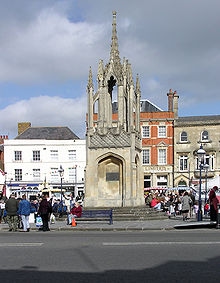 The first known market in Devizes was in 1228. The original market was in the large space outside St Mary’s Church, rather than in the current Market Place, which at that time would have been within the castle’s outer bailey.
The first known market in Devizes was in 1228. The original market was in the large space outside St Mary’s Church, rather than in the current Market Place, which at that time would have been within the castle’s outer bailey.
The chief products in the 16th and early 17th centuries were wheat, wool and yarn, with cheese, bacon and butter increasing in importance later.
In the early 18th century Devizes held the largest corn market in the West Country and also traded hops, cattle, horses and various types of cloth. Before the Corn Exchange was built in 1857, the trade in wheat and barley was conducted in the open, with sacks piled around the Market Cross.
The town sits on top of a hill and such was its importance that the Kennet and Avon canal which links Bristol to London, opened in 1810, was routed up the hill and through the town. A total of 29 locks raise the canal including a flight of 16 locks mounting Caen Hill. On the canal quay is a small museum run by the Kennet and Avon Canal Trust, giving information about the development of the canal, its falling out of use, and the subsequent restoration, as with many canals, following the efforts of hundreds of volunteers. It also includes working models of the Crofton pumping station which we visited in 2015 and the pumping station at Claverton we would visit later in the trip.
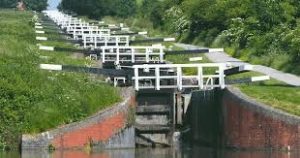 Leaving the brewery in our coach (a few more horsepower), we made a brief stop at the foot of the
Leaving the brewery in our coach (a few more horsepower), we made a brief stop at the foot of the
Caen Hill flight of locks to provide a chance for photographs. Thence onwards to our hotel in Bradford on Avon, passing through Melksham where an Hawker Hunter jet fighter stood at the side of the road.
Devizes Museum Don Cooper
Devizes Museum, more correctly called Wiltshire Museum (it is the county museum), is housed in two Grade II listed early Georgian town houses with a Victorian infill and modern additions. The modern additions include lifts and ramps to all floors and up-to-date toilets. The museum concentrates on Wiltshire county heritage and is organised by time periods, although Upper Floor C tells the story of Devizes. The museum is a charity and dates from 1853.
All time periods are well represented with the four “Prehistoric Wiltshire” rooms being particularly good, highlighting the rich prehistoric landscape of Wiltshire which includes Stonehenge and Avebury.
However, the item that caught my eye was a fossil – a sponge fossil. These sponge fossils seem to have been put to a number of uses.
Some have been found used as money storage or perhaps money boxes (see photo). The Celtic gold coins are replicas of the ones found and there have been at least two other sponge fossils found that had been used for this purpose. The coins were Iron Age and were found at Chute in 1927 and more in 1986 and 1994.
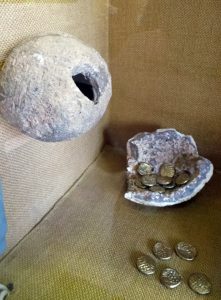 Another use illustrated was pigment holders. These fossils when split in half make a good small mixing bowl when applying colour to an object.In the prehistoric gallery there was a beautifully shaped sponge fossil used to make the head of a mace. It had been partly drilled through and polished, giving the head of the mace a striking look.
Another use illustrated was pigment holders. These fossils when split in half make a good small mixing bowl when applying colour to an object.In the prehistoric gallery there was a beautifully shaped sponge fossil used to make the head of a mace. It had been partly drilled through and polished, giving the head of the mace a striking look.
Figure 1 Sponge fossil used as a money box .
The museum is representative of the best kind of county museum. The artefacts are well labelled, the staff helpful and friendly, and there is a good selection of local books and guides. This visit was a great start to our stay in Wiltshire.
AUTUMN TRIP 2017
Although we have only just returned from our trip to Bradford on Avon, hotels are requiring that bookings for groups are made well in advance. So we are happy to announce that the trip next year will run from Monday 25th to Friday 29th September based at the Best Western Forest Hills Hotel in Frodsham, close to Liverpool and Chester. For the more energetic, the hotel boasts a gym, sauna, jacuzzi and swimming pool.
Prices will remain as this year at £470 per person sharing a twin/double room and £520 per person in a single room. A deposit of £125 per person will be required next March.
This year, several members brought friends on the trip, which is good because it helps share the cost of the coach and keeps the price down. They are more than welcome.
Please let Jo or Jim Nelhams know if you are hoping to come – so that we can reserve sufficient rooms. Contact details are at the end of this newsletter.
Bristol – The Avon Gorge and Henrietta Barnett Micky Watkins
In the 1890s, Henrietta and her husband Canon Samuel Barnett visited Bristol for three months every summer because Samuel was made a Canon of Bristol Cathedral. It was a welcome change from their life and work in the slums of Whitechapel. They used to walk and bicycle in the surrounding countryside. Henrietta saw that the Avon gorge was defaced by stone-quarrying, bare expanses of stone overtaking the woodland. Henrietta, with her secretary Marion Paterson and her adopted daughter Dorothy and friend, scattered flower seeds on the cliffs:
“First the seeds had to be collected; and then in the back garden, the children and I mixed them with earth, stirring all sorts together in the breadpan in Christmas pudding style. Then the packets were made about the size of a tennis ball and tied up in newspaper, and in the evening, in the gloaming, we went out like four conspirators down over the rocks.
Samuel carried the heavy baskets for them but would not throw the parcels because it was illegal. They were all delighted when “the bare rock produced antirrhinum, valerian, yellow alyssum, wild convolvulus, and, undoubted proof that they were the babes of our balls, Iceland poppies of the same strains as grew in our garden.”
The cliffs of the Gorge were purchased by George Wills, cigarette millionaire, to give to the public. When we approached the bridge we saw information about the flora of the cliffs, and the importance of this site of scientific interest. But no mention of Henrietta!
Battle of Barnet snippet Don Cooper
From the Barnet Museum & Local History Museum – August 2016 edition, a report on the Battle of Britain Project:
“In May a team of volunteers helped Sam Wilson [the project leader] with test-pitting in the area that used to be Kitts End Hamlet to try and establish how old the settlement was. They found lots of fragments of pottery and tile which have been dated by the British Museum to the whole medieval period (C11th to C15th), which indicates that the settlement was in existence at the time of the
Battle of Barnet.”
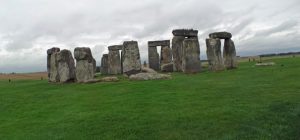 Stonehenge at Risk? Micky Watkins
Stonehenge at Risk? Micky Watkins
Archaeologists and conservation groups are deeply split in their views about the Government announcement of the proposal to bury the A303 in a tunnel under Stonehenge.
English Heritage and the National Trust – owners of the site and the surrounding landscape – are jubilant. But Kate Fielden, representing the Stonehenge Alliance of conservation groups, Friends of the Earth the archaeological group Rescue and Aslan – whose members include pagans and Druids – all say that this short tunnel will cause serious damage to the historic landscape on each side.
Anyone who has used the A303 in the summer will know that the traffic jams extend for miles each side of Stonehenge and something must be done. More acceptable solutions are to make a longer tunnel, or by-pass the site, possibly using the A30 which runs parallel to the A303.
King Arthur’s Palace
A royal palace dating from the 6th century has been discovered at Tintagel. This is the probably the birthplace of the legendary King Arthur.
Cornwall Archaeological Unit is excavating the site. They have found many fragments of pottery and glass which had been imported from Europe and the Middle East by the wealthy people who lived here. There are sherds of imported late-Roman amphorae, fragments of fine glass and of Phocaean red slip-ware which was made in Turkey. In exchange, tin was exported from Cornwall.
Tintagel is one of the most important sites in Europe. Here the Romano-British rulers fought the Anglo-Saxon invaders for control of the island in the fifth century. The castle was built later, in the 1230-40s, by Richard, Earl of Cornwall, brother of Henry III.
Surely Arthur must have lived, for in the sixth century the monk Gildas wrote about him. If Gildas was fabricating a history it would have been disproved by old people with long memories. (Ed’s note: Arthur is not mentioned in Gildas)
The team is supported by English Heritage and this three week dig will be followed by further digs for the next four years.
Newly Excavated 1st Century Roman Bath in Pompeii
The entrance to the bath is through a portico from which you walk through to the changing room which is frescoed with eight numbered erotic scenes of different positions. Above the baths were prostitutes’ rooms. The changing room is floored with marble and the ceiling has stucco reliefs of cherubs and chariots. The cold plunge pool is frescoed with seascapes.
Other newly opened buildings are a merchant’s richly decorated house, a middle class house and a business where the people brought their fabrics to be cared for (dry-cleaners?).
The baths were badly damaged by the earthquake of 62 AD and were still being repaired at the time of the eruption of Vesuvius in 79AD which accounts for the absence of any statues or furniture.
OTHER SOCIETIES’ EVENTS Eric Morgan
Friday 4th November, 7.30 pm. Barnet History Society, Chipping Barnet Library. Gillian Gear Memorial Lecture: Warwick’s War by Karen Clark. Visitors £5.
Wednesday 16th November, 7.30pm. Willesden Local History Society, St Mary’s Church Hall, Neasden Lane, NW10 2TS (near Magistrates’ Court). The Willesden Green Cat Mosaic. Talk by Debra Collis.
Wednesday 30th November – Tuesday 6th December. Barnet Borough Arts Council, The Spires, High St., Barnet EN5 5XY. Art & Info. Exhibition (incl. HADAS details). Part of Barnet Xmas Fair, showing paintings, prints, photographs and textiles.
Friday 2nd December, 7.30 pm. Wembley History Society. English Martyr’s Hall, Chalkhill Rd, Wembley HA9 9EW (top of Blackbird Hill, adj. to church). The Forgotten Industries of Old Kingsbury and Hendon. Talk by Jim Moher, followed by mince pies. £3.
Saturday 3rd December, 9.45 am.-5 pm. Thames Discovery Programme, Foreshore Forum, National Maritime Museum, Greenwich SE10 9NS. Hear Updates from Frog Teams and Speakers. Tickets £20 & booking fee from:
www.thamesdiscovery.org/events/foreshore-forum-2016
Wednesday 7th December 6pm. Gresham College at Museum of London. Tough Choices: Heritage or Housing? Talk by Dr Simon Thurley. Free.
Monday 12th December, 5.30 pm. Society for Post-Medieval Archaeology, Society of Antiquaries, Burlington House, Picadilly. AGM followed by 6pm drinks reception, then 7pm. The Great Wall and the Ceramics Trade, by David Barker. Free, but book at:
www.spma.org.uk
Tuesday 13th December, 6.30 pm. LAMAS, Clore Learning Centre, Museum of London.
Investigations on the Site of Shene Charterhouse undertaken by MOLA and Richmond Archaeological Society in 2011-15. Talk by Bob Cowie (MOLA). Visitors £2. Refreshments from 6 pm.
Tuesday 13th December, 7.45 pm. Amateur Geological Society, The Parlour, St Margaret’s Church, Victoria Avenue, N3 1BD (off Hendon Lane). Our Heritage – Stone Tools and Rock Art. Talk by Bob Harris.
Wednesday 14th December, 2.30 pm. Mill Hill Historical Society, Trinity Church, The Broadway NW7. Whitefriars Glass – The Harrow Years. Talk by Mike Beech.
Comments
No. 547 OCTOBER 2016 Edited by Vicki Baldwin
HADAS DIARY
Lectures start at 7.45 for 8.00pm in the Drawing Room, Avenue House, 17 East End Road, Finchley
N3 3QE. Buses 82, 143, 326 & 460 pass close by, and it is five to ten minutes’ walk from Finchley Central Station (Northern Line). Tea/coffee and biscuits follow the talk.
Tuesday 11th October 2016: Women in Medieval London by Professor Caroline Barron
Tuesday 8th November 2016: The Cheapside Hoard by Hazel Forsyth
Tuesday 10th January 2017: My Uncle, the Battle of Britain, VC by James Nicolson
Tuesday 14th February 2017: London Ceramics at time of the Great Fire by Jacqui Pearce
Tuesday 14th March 2017: Bugging the Nazis in WW2: Trent Park’s Secret History. by Helen Fry
Tuesday 11th April 2017: to be confirmed
Tuesday 9th May 2017: to be confirmed
Tuesday 13th June 2017: ANNUAL GENERAL MEETING
Tuesday 10th October 2017: The Curtain Playhouse excavations by Heather Knight MOLA
Tuesday 14th November 2017: The Battle of Barnet Project by Sam Wilson
New Tours of the WCEC at the British Museum. Audrey Hooson
The British Museum has now started offering free tours of the World Conservation and Exhibition Centre to the public. They are on the last Tuesday of each month in the afternoon with four 80 minute sessions available and need to be booked in advance.
A different department will be featured each month:- 25th October – Western Art on Paper
29th November – Eastern Art on Paper and Silk (Hirayama Studio)
13th December – Ceramics, Glass and Metals. I have done this tour and it is very interesting.
For more information see the Events calendar on the BM web site. To book email volunteers@britishmuseum.org.
Hendon Open Day Don Cooper
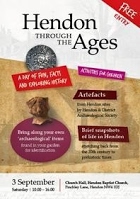 HADAS was very well represented at the Hendon Open Day that took place at the Hendon Baptist Church in Finchley Lane/First Avenue. The event took place on 3rd September 2016.
HADAS was very well represented at the Hendon Open Day that took place at the Hendon Baptist Church in Finchley Lane/First Avenue. The event took place on 3rd September 2016.
The event was instigated by Pastor Errol Jacobs in discussion with Jacqui Pearce, a pottery specialist, from the Museum of London Archaeology. HADAS were asked to participate. The format of the day was short presentations of the history of Hendon through the ages, illustrated by slides and photos of old postcards. Each presentation was about twenty minutes long Jacqui Pearce gave almost all of the presentation and there were individual presentations one each by Vicki Baldwin and Don Cooper.
HADAS set up tables with artefacts from the various digs in Hendon done by HADAS members as well as finds from excavations in the London Borough of Barnet, notably the Moxon collection from the Brockley Hill Roman pottery. We also displayed some of our books and publications.
Memories, the shop at 130-132 Brent Street, also displayed old photos, postcards and maps from their collection.
Refreshments were provided by the Church. There were tours of the Church by Mike who told us all about the fascinating history of the Hendon Baptist Church which was built in the 1880s.
Whilst it would have been good if more visitors had come along to this excellent event, those who came thoroughly enjoyed it. Thanks go to Rev Errol Jacobs for the use of the hall, Jacqui Pearce for her organisation and excellent presentations, to “Memories” for the loan of their collections of photos etc. and also to the HADAS crew led by Bill Bass who put it all together.
Hendon Baptist Church Peter Pickering
The day was held in Hendon Baptist Church Hall, which is the basement of the church; there are pillars which run through the basement and church up to the roof. Mike told us something of the history of the Baptist denomination in Hendon, and the building of the church, and took a tour round it. It is an aisled cruciform building erected in 1883; it was designed by J. E. Sears in an individualistic version of 13th-century Gothic. Mr Sears was a qualified architect member of the congregation, and had an interesting career as a politician; he was a Progressive member of the London County Council, and from 1906 to 1910 Liberal Member of Parliament for Cheltenham. But I have not been able to find any more buildings that he designed.
The church is obviously well-used and cared-for, and did not seem to have suffered from the re-orderings that can obscure original features; the roof was particularly fine. To those of us more used to Anglican churches there were strange as well as familiar features. No pictorial glass in the windows, for instance. Baptists practise baptism of adults, by total immersion, and at what I thought of as the east end, besides a pulpit and a communion table there is a trough in which baptisms take place. (Unfortunately, it was covered over when we were there, but the trapdoor above it is to be seen.) The organ has pride of place, and we were shown the pumping handle by which it used to be powered (and still can be if the electricity fails). The church is on a sloping and elevated site; there is a lift so that the less agile do not have to climb the many steps.
Remembering 1916 – in South Croydon Stewart Wild
I recently visited an excellent World War I exhibition at a school in South Croydon, just off the Brighton Road. It was due to end on 31 August, but due to its success it has been extended well into next year, in fact to 16 April 2017.
The exhibition is located in a hall in the grounds of Whitgift School and is the brainchild of headmaster Dr Christopher Barnett, who gained his doctorate in history among the dreaming spires of Oxford. It took him and his team of trustees, staff and pupils three years to gather a remarkable collection of WWI artefacts from a number of museums and private collections, and to build the exhibition panels and displays on the school premises.
The results are spectacular. All the might and wealth of the Imperial War Museum could not have done better. And to cap it all, they have created a splendid and authentic Edwardian cafe for visitors to relax in, complete with period decoration and furniture.
It took me nearly three hours to see it all, after which I was in need of an Edwardian sandwich and cup of tea. You begin with displays of 1914 recruiting posters and enlistment, after which the accent is firmly on 1916, the year of the terrible carnage on the Somme, the Battle of Jutland, the death of Lord Kitchener and the appalling loss of life at Gallipoli and Verdun.
It was also the year of the Zeppelin airships, the first aerial bombardment of London, and the heroism of Lt William Leefe Robinson, who won the V.C. for being the first to shoot one down.
The exhibition is not in any way triumphalist, and Dr Barnett has gone to great lengths to include French and German voices too, using excerpts from letters, diaries and memoirs. Throughout you are reminded that this is a giant history lesson too.
The team has built several realistic dioramas, not only of front-line tunnels and trenches, but also of an Edwardian parlour on the home front as a reminder of the awful unwanted telegrams that were delivered to grieving households all over the country.
One especially interesting item I found was a postcard from somewhere in France addressed to Mrs W R Wilkes, 21 Highwood Avenue, North Finchley, London N. Dated 19.4.16, the message began “Dear Ma and Pa” and complained mainly about the weather. Unfortunately their son’s name was not legible.
Among the displays of guns, grenades, bayonets, knives and even a knuckleduster, there’s also a range of things the poor Tommies treasured most: soap, foot powder, tobacco and letters from home.
A century-old Sunbeam bicycle and a Triumph motorcycle can be examined in detail. Bruce Bairnsfather’s books and renowned ‘Old Bill’ cartoons bring a touch of light relief.
There are two flags from the Battle of Jutland, an ensign from the British light cruiser Southampton and one from the German battleship Von der Tann. In contrast is an unpublished diary account of what happened as the battle began on 30 May 1916 by a crew member of HMS Inconstant, presumably written with Stephens’ famous blue-black writing fluid since the handwriting hasn’t faded.
The summer of 1916 was also when the Royal Flying Corps first crossed swords with German flying ace Manfred von Richthofen, the ‘Red Baron’. The exhibition features a lot about this legendary character since his first victim, in September 1916, was an Old Whitgiftian named Lionel Morris.
By an extraordinary quirk of fate, it was also an Old Whitgiftian who performed the autopsy on the Red Baron when he was finally shot down over Amiens two years later. Imaginative displays tell the whole story.
The exhibition is open daily, 10am to 5pm and there is free parking on site. Alternatively, the Whitgift Exhibition Centre is ten minutes’ easy walk from South Croydon station.
Further information: www.remembering1916.co.uk
Glasshouses Vicki Baldwin
During a recent visit to Heligan in Cornwall I was struck by the variety of structures that fall under the description ‘glasshouse’ and how they were adapted to fit situation and purpose. There were coldframes, lean-tos, full height, half-height, the ‘pineapple pit’ utilising horse manure to produce heat, and portable single plant covers. They were built into corners and against south-facing walls to maximise warmth. Access was by door, sliding panel, hinged window or, in the case of the very small examples, removable top.
These glasshouses not only enabled the gardeners to produced food all year round, but also allowed for experimentation and the growing of more exotic species such as melons (each hanging in its own net for support) and the highly desirable pineapple. In addition, the Flower Garden has the Orchid House and “possibly the last remaining Paxton House in Britain” (Heligan Centenary Guide Book, updated 2016). Apart from the small, portable example, all these structures are supported on low, brick walls to raise the wooden parts above the ground. In many cases “beaver tail” glazing was used to divert rainwater away from the vulnerable wooden frames. This is visible in the pictures below.
As mentioned, the heat produced by decomposing horse manure was one method of regulating optimum growing conditions. Later, coal fired boilers were installed in the houses, and keeping them stoked become an additional task. The boilers varied in shape and size, and a Horseshoe Boiler can be seen behind the Melon House.
All very interesting, but what is the relevance? Well, the area we have excavated in the grounds of Avenue House in 2014 and 2015 is shown as glasshouses on a map of 1894-1896. In addition, a visitor to the house mentions passing the glasshouses on the drive. Until I visited Heligan, I had not fully realised the possible diversity of the structures we were investigating. We know that there was an extensive water management system in the grounds of Avenue House, indeed we discovered a large cistern below the structure we were excavating in 2015. However, although we can uncover the footprint of the glasshouses, without any photographs or pictures we can only guess at the form of the superstructure.
1.’Lean-to’; 2. Beavertail glazing; 3 & 4. Various low frames; 5. Portable structure with removable top; 6. Banana House.
National Library of Scotland – A mapping resource for HADAS
Roger Chapman
You might not think that the National Library of Scotland would be a good place to look for mapping resources for Barnet but currently I know of no better for historical map research of our area. The National Library of Scotland has over 150,000 high resolution historic map images. Naturally the focus is on Scotland but the collection includes detailed Ordnance Survey map series of England and Wales. It is also a collection that is growing and is worthwhile going back to from time to time. One of the features that I particularly like about this collection is the ability it gives to look at historical maps superimposed on to modern satellite photographs or mapping.
This article aims to explain how to go about this in a simple and straightforward manner. It will certainly give you hours of enjoyment on wet winter days looking at the changes that have taken place over the past 100 – 150 years in our local area – or indeed anywhere else in the UK that may interest you.
Google “National Library of Scotland” and follow the link or type www.maps.nls.uk into your web browser.
You should then be looking at the screen below.
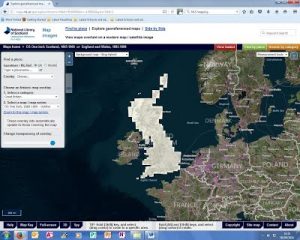 Step Two:
Step Two:
At the bottom of the page, adjacent to “Other links” you will see a light blue box entitled “Georeferenced overlays”. Click on this and you will be taken to the page below.
Step Three:
In the light blue box to the top left of the screen type the place you are looking to find in the box that says “Type a place-name” In the example below I typed “Finchley “ which the programme decided should be changed to “London UK” but it worked and took me to the Finchley area. That is often enough but you can also select the county if you wish. Oddly the Parish drop down box doesn’t include Finchley or Hendon at the moment.
You also need to “choose an historic map overlay” from the light blue box above. In 1. Select a category. I chose “England and Wales” from the drop box by clicking the arrow on the right hand side. In 2. “Select a map/map series” I chose “OS 25 inch 1890’2-1920’s [Note that the coverage for historic map layers may not yet be complete so some overlays may not be available at the moment.]
The area that you have chosen and the historic map layer should now show up as in the image below.
Step Five:
At the bottom of the box headed “Find a place” is a blue button under the heading “Change transparency of overlay” Toggle this to the left and the historic map begins to be shown against a modern satellite photograph. You can use this to increase or decrease the transparency of the overlay/satellite map. See next image below.
Step Six:
Near the top of the map is a white horizontal box with the text “Background map – Bing hybrid” This is the Background map which shows above. Use the dropdown box to find other options for background maps and see which one works for you.
Other things to do:
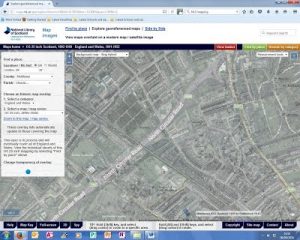 There are many other options to play around with. Use the + and – buttons near the top of the page to zoom in to areas you wish to examine in detail. The slider symbol under the + and – signs performs the same function.
There are many other options to play around with. Use the + and – buttons near the top of the page to zoom in to areas you wish to examine in detail. The slider symbol under the + and – signs performs the same function.
You can also use the measurement tool box (towards the top right hand side of the screen) to measure the distance between two objects or to measure areas of buildings, fields or whatever takes your fancy.
There is plenty of scope and a lot of fun to be had with this amazing online resource. Currently I am using it to identify old demolished buildings in Finchley and finding out if they are on publicly accessible sites for future possible HADAS excavations. It is also incredibly useful to look at sites where planning applications are being proposed to see what, if anything, existed on the site beforehand.
***PLEASE NOTE***
‘Hertfordshire at War’ Annual Symposium
Saturday 12th November: 10.00am – 4.30pm, Herts Association for Local History, Ewen Hall, Wood Street, Barnet EN5 4BW
Full details and cost in ‘Other Societies Events’ section below
Other Societies’ Events Eric Morgan
Tuesday 4th October: 3pm, Finchley Society. 5 Graywood Court, N12.
Joseph Grimaldi Blue Plaque & Information Panel Unveiling Ceremony. Griff Rhys Jones, will unveil the plaque. The information panel, designed by Peter Marsh (Hadas Member), will also be unveiled in the grounds of Finchley Memorial Hospital. Griff is President of Civic Voice.
Monday 10th October: 2.30 for 3.00pm, Barnet & Local History Society, Church House, Wood St, Barnet, (opposite museum). The development of The English Country House: medieval to 20thC. Talk by Pamela Wright. Visitors £2. Also Wednesday 23rd November, 8pm, AGM.
Saturday 22nd October: 9.45am – 4.30pm, Enfield Society, Jubilee Hall, 2 Parsonage
Lane/junction Chase Side, Enfield EN2 0AJ. Day Conference – The changing face of Local History
– Edmonton Hundred History Society 80th Anniversary. For more details please visit www.edmontonhundred.org.uk
Thursday 27th October: 8.00pm, Finchley Society, Drawing Room, Avenue House, East End Road N3 3QE. Air Pollution & Victoria Park. These are 2 topics for the discussion meeting mentioned in the HADAS Sept Newsletter. The Air Pollution Survey of North London results will be given by Chris Church. The Victoria Park Projects update will be given by someone from Barnet Council. Visitors £2. Also Thursday 24th November 8pm Footsteps of the Famous. Jean Scott Memorial Lecture by Paul Baker.
Thursday 27th October: 7.30pm, Camden History Society, Burgh House, New End Square, NW3
1LT. ‘When Sigismund Came to Dine’, Prof Lester Hillman on an event that occurred 600 years ago in Kentish Town with William Bruges 1st Garter King of Arms. Sigismund became Holy Roman Emperor (1433-7).
Monday 31st October: 5.30pm, LAMAS. Spooky tour of Spitalfields Medieval Charnel House. Led by Jane Sidell (Inspector of Ancient Monuments) including a short talk. Meet outside Ca Restaurant,
corner of Spital Square, EC2. Non-members £5 on the night, book by email
Jane.Sidell@btinternet.com or write to Jane Sidell, 113, Lion Lane, Haslemere, Surrey.
Tuesday 1st November: 7.30pm, Enfield Society, Jubilee Hall, 2 Parsonage Lane/junction Chase Side, Enfield EN2 0AJ. Presenting Enfield – A Spoon Full of Sugar, talk by Joe Studman on the development of the of the health service in Enfield from folk remedies to North Middlx Hospital.
Wednesday 2nd November: 6pm, Gresham College at The Museum of London, 150 London Wall EC2Y 5HN. Saving the Twentieth Century. Talk by Dr Simon Thurley, free, on most threatened buildings in Britain built in the 20thC.
Thursday 3rd November: 8.00pm, Pinner Local History Society, Village Hall, Chapel Lane Car
Park, Pinner. Elspeth McClelland and Pinner’s Suffragettes, talk by Thamar Maltver.
Visitors £3. Also Thursday 6th Oct, 8pm, Elizabeth Rogers of Eastcote House: An 18thC Lady of Property, talk by Eileen Bowlt (LAMAS).
Saturday 5th November: 10.30am – 4.30pm, G. A Festival of Geology, UCL, Gower Street, WC1E
6BT. Displays by Geologists’ Association Members and Affiliated Societies (Amateur Geological Society will have a stand there). Sales of fossils & minerals, books, maps and geological equipment, amateur photographic competition, geological talks & walks, free entrance.
Wednesday 9th November: 2.30pm: Mill Hill Historical Society, Trinity Church, The Broadway, NW7. Daily life in Verulamium, talk by David Thorold.
Wednesday 9th November: 7.45pm, Hornsey Historical Society, Union Church Hall, Corner of Ferme Park Rd/Weston Park, N8 7PX. Darling Daisy, talk by Dr Neil Houghton. Visitors £2, refreshments, sales and info from 7.30pm. Also Wednesday 12th October, 7.45pm, The Great Fire of London, talk by Marianne Zieran.
Friday 11th November: 7.45pm, Enfield Archaeological Society, Jubilee Hall, 2 Parsonage
Lane/junction Chase Side, Enfield EN2 0AJ. Roman Pottery Making in Highgate Wood Archaeology & Experiment. Presidential Address given by Harvey Sheldon (also HADAS President). Visitors £1, refreshments, sales and info from 7.30pm.
Saturday 12th November: 10.00am – 4.30pm, Herts Association for Local History, Ewen Hall, Wood
Street, Barnet EN5 4BW. ‘Hertfordshire at War’ Annual Symposium, including The Battle of
Barnet Project, The Second Battle of St Albans, How the Civil War Affected Herts 1642-1652, The
Home Front During WWI, Salisbury Hall & The De Haviland Aircraft Co. Tickets non-members £15 (£12 HALH members). Hot lunch available if booked in advance, £10. To order tickets please visit www.stalbanshistory.org. For further details see www.halh.org.uk or contact Ruth Jeavons, 44, Necton Road, Wheathampstead, Al4 8AU. Tel 01582 629516.
Saturday 12th November: Enfield Society, Dugdale Centre, Enfield Museum, 39 London Road, Enfield EN2 6DS. ‘Enfield The Time of Change’ Day Conference on Enfield in the last century, including talks on the history of Enfield by Monica Smith, Enfield in WWI by Ian Jones (including a walk around Enfield Town looking at buildings the society has helped to save over the past 80 years led by Joe Studman and Dave Cockle. Also other activities in the museum. Cost (to include lunch, coffee & tea) is £15. To book a ticket please send name & telephone no. & include a SAE and cheque payable to The Enfield Society to Conference, Jubilee Hall, 2 Parsonage Lane/junction Chase Side, Enfield EN2 0AJ. Or try to book at www.enfieldsociety.org.uk/conference by card or PayPal.
Wednesday 16th November: 2.30pm, Edmonton Hundred History Society, Jubilee Hall, 2 Parsonage Lane/junction Chase Side, Enfield EN2 0AJ. Another Kind of Life: Dickens and the Theatre, talk by Dr. Tony Williams, visitors £1.
Thursday 17th November: 7.30pm, Camden History Society, Camden Local Studies and Archive Centre, 2nd Floor, Holborn Library, 32 Theobalds Road. Filmed in Camden, talk by Danny Nissim, visitors £1.
Friday 18th November: 7 pm, Fri 21st Jan: 7.30pm, CoLAS, St Olave’s Parish Hall, Mark Lane, EC3. Discoveries at Happisburgh, talk by Dr Nick Ashton.
Saturday 19th November: 10.30am – 6pm, Weston Theatre Museum of London, 150 London Wall,
EC2Y 5HN. LAMAS Local History Conference: ‘Walking Through London’s History’. Tickets £12.50 before 31st October or £15 from 1st November. Include a SAE and cheque payable to LAMAS or PayPal via www.lamas.org.uk/conferences/local-history.
Wednesday 23rd November: 7.45pm, Friern Barnet & District Local History Society, North Middlx
Golf Club, The Manor House, Friern Barnet Lane, N20 0NL. ‘Upstairs at the Gatehouse – Highgate’s Theatre’, talk by John Plews, visitors £2.
Saturday 26th November: 10.00am – 3pm, Trinity Church, 15 Nether Street, N12 7NN. Amateur Geological Society’s Mineral, Gem and Fossil Show. Including rocks, books, crystals, gemstones and jewellery. Refreshments, admission £2, please note new time and venue.
No. 546 September 2016 Edited by: Sandra Claggett
HADAS DIARY 2016/17
Saturday 3rd September 10am to 4pm. HADAS Open Day. Hendon Baptist Church Hall, Finchley Lane, Hendon NW4 1DJ. Display of artefacts from Hendon sites & a series of brief snapshots of life in Hendon. FREE including refreshments.
Monday 19th to Friday 23rd September: Trip to Bradford-on-Avon.
Tuesday 11th October @ 8pm: Women in Medieval London. Lecture by Professor Caroline Barron.
Tuesday 8th November @ 8pm: The Cheapside Hoard. Lecture by Hazel Forsyth.
Tuesday 10th January @ 8pm: My Uncle, the Battle of Britain VC. Lecture by James Nicolson.
Tuesday 14th February @ 8pm: To be confirmed.
Tuesday 14th March @ 8pm: Bugging the Nazis in WW2: Trent Park’s Secret History. Lecture by Helen Fry.
All Lectures are held at Stephens House & Gardens (Avenue House), 17 East End Road, Finchley, N3 3QE, and start promptly at 8.00 pm, with coffee /tea and biscuits afterwards. Non-members welcome (£1.00). Buses 82, 125, 143, 326 & 460 pass nearby and Finchley Central Station (Northern line) is a short walk away.
Mesolithic Hunters and Gatherers of West Heath, Hampstead: Time, Landscape and Place by Melvyn Dresner
As part of my Masters in Archaeological Practice at Birkbeck College, I am examining what life was like in the Mesolithic past in North London based on evidence collected by HADAS members and stored in the LAARC – London Archaeological Archive and Research Centre. Around 11,000 years ago, people lived on the high ground at West Heath, Hampstead, hunting red deer, living off other forest resources such as hazelnuts, hunting or cohabitating with beavers, and eating the occasional odd swan.
West Heath, Hampstead was dug by HADAS members in the 1970s and 1980s and published
1989. Much of the analysis was based on spatial patterning and tool typology. I’m working through this analysis of lithic tools to see if there is evidence for duration of occupation and comparing postholes found there with similar finds at Howick, Northumbria, and Star Carr, Yorkshire, where dwellings have been interpreted and reconstructed experimentally, as well as faunal evidence at Three Ways Wharf, on the River Colne, where red deer, swan and beaver were found.
At that time the Thames was a tributary of the Rhine and the southern North Sea was land where people lived. We know about these people mainly from the stone tools they made, including micro-lithic tools, serrated edges, and axes – these and other tools point not only to hunting but also working skins (scrapers), tailoring by sewing skins together (piercers), wood and bone working (burin, axes, serrates and saws) as well as hafting pointing toward use of twine/adhesive. We term these people as Mesolithic based on micro-lithic and axe technology and relationship with the Boreal/Atlantic forest – a period that lasted more than 4,000 years. West Heath can be dated to this early period when birch forest was being replaced by hazel and oak.
Work by Bryony Coles in France on beavers’ re-colonisation suggests how we can consider beavers during the Mesolithic in Britain making the environment desirable by building dams in places such as West Heath – holding nutrients on higher ground, attracting water fowl, fish, as well as grazing animals (red deer) and their predators such as wolf and people. Recent publications add to the picture of Mesolithic wood-working; bone and wood was mainly lost at West Heath due to the acidic soil. Through strontium isotope analysis (- Langford, Essex – first time used on human remains from this period in Britain, published earlier this year in the Mesolithic Miscellany, June 2016) it seems to show people are more attached to place and spend their life on limited geology.
The people of West Heath are likely to be highly mobile though the lithic scatters relate to postholes in plan and depth suggests people were here over a long period in two or three phases. Over 61,000 lithic items were found at West Heath, including over 800 identified tools. I’m only using a small sample to investigate this aspect in three trenches (still more than 2,000 lithic artefacts), learning about people who lived locally 11,000 years ago from evidence collected 40 years ago.
Selected Bibliography
Coralie Acheson (Archaeology) James Dixon, Charlotte Bossick (Built Heritage), Juan Jose Fuldain,
Carlos Lemos (Graphics), Museum of London Archaeology (MOLA), HAMPSTEAD HEATH, London Borough of Camden Historic Environment Assessment, June 2013
Archaeological Research Services Ltd (2012) Howick Project [dataset]. York: Archaeology Data
Service [distributor] (doi:10.5284/1017454)
Bryony Coles 2006, Beavers in Britain’s Past, Oxbow Books and WARP
Desmond Collins and Daphne Lorimer, Excavations at the Mesolithic Site on West Heath, Hampstead 1976 – 1980, Hendon and District Archaeological Society, BAR British Series 217, 1989
John S C Lewis, with James Rackham 2011, Three Ways Wharf, Uxbridge: A Late Glacial and Early Holocene hunter-gatherer site in the Colne valley, Museum of London Archaeology
S Maroo and DW Yalden 2000, The Mesolithic mammal fauna of Britain, Mammal Review 30, 243– 248.
Sara A. Rich, Ryan Watts and Garry Momber, Mesolithic woodworking, experimental archaeology & underwater heritage in Hampshire and the Isle of Wight (UK), Mesolithic Miscellany, Volume 24: Number 1, June 2016
Rick Schulting, Christophe Snoeck, Louise Loe, Nick Gilmour, Strontium isotope analysis of the
Mesolithic cremation from Langford, Essex, England, Mesolithic Miscellany, Volume 24: Number 1, June 2016
^^^^^^^^^^^^^^^^^^^^^^^^^^^^^^^^^^^^^^^^^^^^^^^^^^^^^^^^^^^^^^^^^^^^^^^^^^^^^^^^^^
Simon Williams writes a response to the “The Great Stink / The Cholera / Bazalgette lecture, London, 1858” article written by Stewart Wild in August’s Newsletter
The following gives an eye-witness account of this aspect of London, in the form of Jacob’s Island, a rookery situated straddling the Thames at Bermondsey, just east of St.
Saviour’s Dock / The River Neckinger. It was Fagin’s Den in Oliver Twist, with Sikes & Nancy. Chapter 50: “inhabitants on either side lower from their back doors & windows, buckets, pails, domestic utensils of all kinds, in which to haul the water up …. & when the eye is turned from these operations to the houses themselves, utmost astonishment will be excited from the scene before him. Crazy wood galleries common to backs of half-a-dozen houses, with holes from which to look upon the slime beneath; windows, broken & patched ……. Chambers thrusting out above the mud, & threatening to fall into it, as some have before ……”
Mayhew’s London Characters (information gathered in 1867) describes it as a pest-nest: “against the posts of the bridges, were swollen carcases of dead animals ready to burst. At the back of every house were pig-sties…. One of the inmates replied ” Neither I nor my children know what health is”. If another inmate put his hand against the wall behind him, it would be covered by the soil of his neighbours privy, sopping through the wall …. Its inhabitants were wont to leave the murky hauled liquid to stand, so that they might after it had been left to settle for a day or two skim the fluid from the solid particles of filth & pollution which constituted the sediment…..Each epidemic of: typhoid, cholera, typhus, influenza, & scarletina came back summer after summer.” These dwellings were rented.
It might be a surprise that these conditions persisted even after the introduction of clean piped water & sewers legislation, but that didn’t apply to the poorest!
NB Simon plans to bring us more on ‘Mayhew’s London Characters’, in the next Newsletter
Hadrian’s Wall: Life on Rome’s northern frontier. Lecture by Matthew Symonds on 10th May 2016 Sue Willetts
This was a fascinating and well-illustrated talk by the editor of Current Archaeology who has a long-standing interest in, and enthusiasm for, the study of Hadrian’s Wall. The traditional concentration on structures and their military aspects has obscured the archaeological potential of this frontier zone and the complex relationship between an imperial state and local tribal groups. Some have seen the wall as a way to control movements and communications in a largely peaceful environment – a type of customs barrier – while others have emphasised the defensive function due to a genuine military threat. The brief mention in the classical sources that Hadrian ‘was the first to construct a wall, eighty miles in length, which was to separate the barbarians from the Romans’ [1] has been and still is the subject of much debate. Matthew set the scene by showing an atmospheric reconstruction painting (by Alan Sorrell) of a fort on the wall and mentioned modern structures such as The Berlin Wall for comparative purposes.
The wall was originally planned to be 76 Roman miles running from Newcastle to Bownesson-Solway on the Cumbrian coast and constructed to take advantage of the higher ground to the north of the Stanegate – a road which linked the Tyne and the Solway. The wall was later extended to Wallsend on the east to make a length of 80 Roman miles. Hadrian’s Wall may have been ordered by the emperor when he visited the province in AD122 as a response to some major unrest among British tribes c117 AD and it appears that the original plan was to have a wall of stone or turf fronted by a wide and deep ditch with 80 milecastles – a mile apart (in theory) each containing a small group of soldiers. Between each milecastle were 2 evenly spaced small turrets which were watchtowers – lookout posts which could also be used for signalling. But due to the nature of the terrain some structures were placed at more suitable positions. A number of extra forts on the line of the Wall itself were a late addition to the original plan. The wall took at least six years to complete and was built in sections by legionaries but once built was manned by auxiliary units from all over the Empire. Each fort housed a single auxiliary unit with infantry or cavalry soldiers, or both.
Dependent communities of traders and camp followers were established in vici close to the forts such as the one at Vindolanda. These would have housed a mix of locals and people from across the Empire, including retired soldiers and their dependents. Inscriptions show that soldiers and civilians came from as far as Spain, Germany and Syria. We know much about daily life, including a birthday invitation (no. 291) from the wooden writing tablets found in water-logged conditions from this site http://vindolanda.csad.ox.ac.uk
There has been much debate about the purpose of the wall and it is now generally agreed that it acted both as a visible demonstration of Roman power and influence, even more so if, as has been suggested, it was plastered and whitewashed. While the wall did mark a Roman frontier (extended to the north later with the Antonine Wall) it was also to make security checks, controlling the passage of people and goods and where taxes / dues could be collected. A deep ditch known as the vallum to the south was added, still visible in sections today. There is more research to be done on understanding the turf sector at the western end, so too the vallum as well as the civic settlements, Mithraeum and cemeteries which have been revealed by geophysical surveys which will add to our knowledge. So too will further studies on the time after Hadrian as well as on material remains like the “Staffordshire moorlands pan” which names the Wall, as well as inscriptions and writing tablets. In addition, new planning regulations have revealed unknown roads, villas and rural settlements including evidence of roundhouses north of Newcastle allowing further study on the impact of the frontier on the local population, which will add to our knowledge of this important monument.
These links are useful for anyone planning to visit or for further study:
http://hadrianswallcountry.co.uk/
http://www.english-heritage.org.uk/visit/places/hadrians-wall/plan-your-visit
https://www.futurelearn.com/courses/hadrians-wall/ (The speaker contributed to this course)
Correction to earlier newsletters
Tuesday 11th October 2016
Prof Caroline Barron will be speaking on Women in Medieval London for HADAS and not Doctor Caroline Cartwright as listed in the August newsletter.
New course organised by the Mill Hill Archaeology Study Society
For 10 weeks from 7 October 2016, Allan Wilson will be the tutor for a course on
The Western Roman Empire at a cost of £75.00. The Society’s meetings are held on
Fridays 10am – 12.00 at: The Eversfield Centre, Eversfield Gardens, Mill Hill, NW7 2AE
Each session lasts 2 hours, including coffee break. The session style is friendly and informal, combining lectures, visual material and course handouts; debate and discussion are encouraged. If anyone is interested please contact their Secretary for further details:
Secretary: Peter Nicholson, 4 Frinton Court, Byron Road, Mill Hill, NW7 4AE Tel: 020 8959 4757 email: peter@mhass.co.uk
Note for HADAS newsletter from Andrew Selkirk
Many members of the society will know of the resistivity meter which the society uses with great success. This was provided by the Council for Independent Archaeology, which set out to produce a resistivity meter which would be affordable for local societies. Over 100 were produced, but unfortunately production then had to cease due to an EU directive forbidding lead soldering – which was very necessary in producing the actual meter. However Bob Randall, the electronics wizard who produced the meter, has now produced a Mark 2 which is a great upgrade of the whole meter. This features a computer tablet – it will work with any Android tablet – which is attached to the meter and will record the results of the survey as the survey proceeds. This means that the area of the survey can be adapted according to the results.
The meter will receive its first public demonstration at the annual conference of the Council for Independent Archaeology, which will be held at Toddington (Dunstable) – on the 24th September 2016. The venue is in fact at a pioneering venue, the Poplar’s Garden Centre, which is just off the M1 at the Toddington turn-off. They have just added an education centre to their facilities which the CIA is hiring for the day. It should be easily accessible to HADAS members – it is only half a mile off the M1.
A feature of the conference will be the work of the local society. The conference will be held in conjunction with the Ampthill and District Archaeological and Historical Society and will feature the excavations at Ampthill Castle where the society did an extensive geophysical survey in advance of the professional-led excavations — which proved to be something of a fiasco. We will be visiting the site of the excavations as an add-on to the conference on Sunday, 25 September.
Details of the conference can be seen on the CIA website at www.independents.org.uk . Email Keith Foster on skfoster@btinternet.com to make a booking.
Further details from Andrew Selkirk – andrew@archaeology.co.uk
Details of other societies’ events by Eric Morgan
Saturday 17th September. Barnet Museum and Local History Society. Coach outing to Rochester. For details please contact Dennis Bird at 87 Hadley Highstone, Barnet, EN5 4QQ.
Telephone 0208 449 0705 or Barnet Museum on 020 8440 8066. Email: enquiries@barnetmuseum.org.uk. Cost £16.
Saturday 1st October, 10am-4.30pm. St Albans Archaeological Research and resolve group. Verulamium Museum, St Michael’s Road, St Albans. Archaeology in and around St Albans, past and present. A conference in conjunction with St Albans and Herts Architectural and Archaeological Society. Please see the website http://www.stalbanshistory.org for details. £10 (£7 Conc.)
Tuesday 4th October, 7.30pm. Enfield Society. Jubilee Hall, 2 Parsonage Lane, Enfield, EN2 0AJ. Preserving Enfield, cultivated residents. Talk by Joe Studman. £3.
Monday 10th October, 1pm. Gresham College at Museum of London, 150 London Wall, EC2Y 5HN. This and the next 3 Gresham talks are FREE. The early river Thames: The Iron Age and before by Jon Cotton.
Friday 14th October, 7.45pm. Enfield Archaeology Society. Jubilee Hall, 2 Parsonage Lane, Enfield, EN2 0AJ. Verulamium revealed, Kris Lookyear.
Friday 14th October to Sunday the 16th of October. Conference at Royal armouries at the Tower of London, 1066: interpreting the Norman Conquest. Contact bookings at bookings@armouries.org.uk or tel. 0113 230 1888.
Monday 17th October, 1pm. Gresham College at Museum of London. The growth of London as a port from Roman to Medieval times. Gustav Milne.
Wednesday 19th October, 7.30pm. Willesden Local History Society. St Mary’s Church Hall, Neasden lane, NW10 2TS. Clitterhouse Farm. Roger Chapman (HADAS) on the latest information.
Friday 21st October, 7pm. COLAS. St Olave’s Parish Hall, Mark Lane, EC2R 7LQ.
Quarrying and selective deposition in Roman Ewell. Alexis Haslam (P.C.A) Visitors £2.
Friday 21st October, 7.30pm. Wembley History Society, English Martyrs Hall, Chalkhill Rd, Wembley HA9 9EW (top of Blackbird Hill). Cutting edge. Lester Hillman on the 200th anniversary of the opening of the Regents Canal. Visitors £3. Refreshments 50p.
Monday 24th October, 1pm. Gresham College at Museum of London. From sail to steam: London’s role in a shipbuilding revolution. Elliott Wragg.
Wednesday 26th October, 7.45pm. Friern Barney and District Local History Society. North Middx Golf Club, the Manor House, Friern Barnet Lane, N20 OWL. Queens of Henry the VIII. Gary Fisher. Visitors £2.
Thursday 27th October, 8pm. Finchley Society. Drawing room, Avenue House, East End Road, N3 3QE.Discussion meeting. For further details please see their Sept/Oct Newsletter. Visitors £2.
Monday 31st October, 1pm. Gresham College at Museum of London. The port of London and its future. Doctor Riggs.
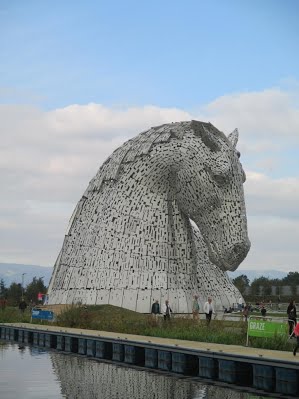
No. 545 AUGUST 2016 Edited by Stephen Brunning
HADAS DIARY 2016/17
Saturday 3rd September 10am to 4pm. HADAS Open Day. Hendon Baptist Church Hall, Finchley Lane, Hendon NW4 1DJ. Display of artefacts from Hendon sites & a series of brief snapshots of life in Hendon. FREE including refreshments.
Monday 19th to Friday 23rd September: Trip to Bradford-on-Avon.
Tuesday 11th October @ 8pm: Women in Medieval London. Lecture by Dr Caroline Cartwright.
Tuesday 8th November @ 8pm: The Cheapside Hoard. Lecture by Hazel Forsyth.
Tuesday 10th January @8pm: My uncle, the Battle of Britain VC. Lecture by James Nicolson.
Tuesday 14th February @8pm: To Be Confirmed.
Tuesday 14h March @8pm: Bugging the Nazis in WW2: Trent Park’s Secret History. Lecture by Helen Fry.
All Lectures are held at Stephens House & Gardens (Avenue House), 17 East End Road, Finchley, N3 3QE, and start promptly at 8.00 pm, with coffee /tea and biscuits afterwards. Non-members welcome (£1.00). Buses 82, 125, 143, 326 & 460 pass nearby and Finchley Central Station (Northern line) is a short walk away.
Free University on-line courses (at FutureLearn):
HADRIAN’S WALL – starting 7th November. Enrolling now.
EXPLORING ENGLISH: MAGNA CARTA (started 18th July).
HOMO FLORESIENSIS UNCOVERED: THE SCIENCE OF ‘THE HOBBIT’ (started 18th July).
Plus many more……….
Altogether there are over 50 courses from Family History to Climate Change, plus a couple on Shakespeare. All are on-line & free. All the material is provided; no books to buy/ read, essays or exams. Learning is by dialogue with tutors/other students. All the material is accessible on-line (once enrolled) at any stage, so it’s easy to join late, & catch up if necessary.
An unexpected interesting by-product with these courses is the chance to converse with fellow students/ enthusiasts located literally all over the planet!
https://www.futurelearn.com
British Archaeological Awards winners announced at the British Museum in July
Historian Bettany Hughes and archaeologist Julian Richards presented awards to some of the UK’s leading archaeologists, showcasing new discoveries up and down the country that are transforming our understanding of Britain’s past.
The 2016 winners reflect the rich diversity of archaeology across the UK, from the industrial archaeology of the Welsh Slate industry, winner of ‘Best Book’, to the major discoveries being unearthed Under London and in Cambridgeshire at Must Farm, which was awarded ‘Best Discovery’ for reshaping our knowledge of the British Bronze Age.
In a presentation about his Highly Commended Stonehenge book, Mike Parker Pearson reflected on the British public’s increasing fascination with the distant past, fuelled by technological advances, archaeological innovation and new knowledge.
Sharing the excavation with the public was central to Oxford Archaeology South’s winning Westgate project
– the largest ever archaeological site in Oxford, while enabling readers to examine the unique Mesolithic Star Carr pendant for themselves using digital publishing technologies was the focus of the Postglacial project’s electronic article in Internet Archaeology.
Community engagement and passion for their shared past shone through the Battles, Bricks and Bridges project, which brought together archaeology and reminiscing to identify a previously disputed battlefield site in County Fermanagh and restore a seventeenth-century bridge, turning villagers’ memories of history and culture into heritage for future generations.
The excavator of Danebury Hill Fort, the Sacred Spring in Bath and Fishbourne Roman Palace, Professor Sir Barry Cunliffe CBE, was recognised for his own exceptional contribution to our understanding of the past with an Award for Outstanding Achievement. In an inspiring acceptance speech, Barry called archaeology “a family”, saying that archaeologists all shared the desire to communicate their knowledge and were “creative, vital and inclusive”.
DCMS Heritage Minister, Tracey Crouch presented the Best Community Engagement Award, commenting:
“Archaeology is such an important part of our nation’s heritage, helping us understand our culture and how people lived in the past.”.
The Great Stink, London, 1858 Stewart Wild
It’s difficult to imagine living conditions in London 160 years ago, when overcrowded cities were unhealthy places to live, disease was rife and the stench of horse manure and human waste was pervasive.
Deaths from sickness were at a level not seen since the Black Death. In London, with a population of three million, the problem was becoming a crisis. Thousands of homes still had stinking cesspits beneath them and in the poorest areas this vile effluent oozed up through the floorboards.
In 1847 the newly formed Metropolitan Commission of Sewers took action, banning all cesspits and stating that all privy refuse should be discharged in the sewers. This added to the waste from the water closets which had recently become popular among the city’s richer residents.
However the sewers were little more than storm drains and so the new law simply meant that all human waste flowed straight into London’s rivers and then into the Thames. As a result, a cholera epidemic (1848–
49) killed over fourteen thousand Londoners and the smell over London got worse. Only essential commercial traffic continued to ply the river.
Toshers
In the 1850s and 1860s poor Londoners found a new source of income. Those hardy souls prepared to enter the sewer outfalls during low tide scoured the mud for old metal, coins, clothes and rags and anything else that could be sold later. These sewer-hunters, or ‘toshers’, as they were known, always travelled in groups of three or four for safety, armed with a long rake which guarded against vermin but which could also be used for pulling themselves out when they got stuck in the mud or sludge.
The venerable social reformer Henry Mayhew, in his London Labour and the London Poor (fourth volume, 1861) estimated that this unconventional trade was worth overall around £20,000 a year, a tidy sum to say the least.
Disraeli’s eloquence
Then in 1858 a long very hot summer made the stench unbearable. Tons of chalk, lime and carbolic acid were tipped into the Thames but nothing could mask ‘The Great Stink’. Sheets were hung on the riverside windows of the House of Commons and soaked in chloride of lime solution (bleach), to no avail. Prime Minster Benjamin Disraeli described the river as “a Stygian Pool reeking with ineffable and unbearable horror.” MPs were forced to act.
Within eighteen days a bill was passed and the railway engineer Joseph Bazalgette (1819–91) was tasked with the vast job of building London’s sewers, apparently on the recommendation of Isambard Kingdom Brunel, also of Huguenot descent.
Bazalgette’s genius
Bazalgette and his team began work in 1859 and in the following nine years, and at a cost of £4.2 million (£500 million in today’s money) they built four pumping stations, 82 miles of intercepting sewers parallel to the Thames and 1,100 miles of street sewers with outfalls at Barking and Crossness; much of this is still in use today.
The Observer described Bazalgette’s work as “the most extensive and wonderful feat of modern times”. The system was officially opened by the Prince of Wales in 1865 although the whole project was not actually completed for another ten years.
The entire network was somewhat over-engineered, with sewer diameters far greater than was needed at the time, but Bazalgette’s foresight together with the quality of the brickwork and sound Victorian engineering have meant that the system generally still works well today.
Bazalgette lived at 17 Hamilton Terrace, St John’s Wood; he is commemorated by a blue plaque that was placed on the house in the 1970s. Towards the end of his life he moved south of the river, to a house in Arthur Road, SW19, where he died, perhaps from overwork, in 1891. He is buried in nearby St Mary’s Church in Wimbledon Village where there is a mausoleum to his memory. There is a second memorial on the Victoria Embankment, a major part of his subterranean achievements.
The Three Bridges, Southall Jim Nelhams
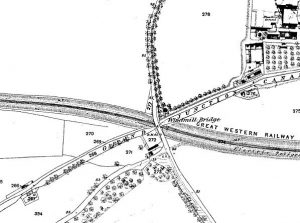 Southall is on the Grand Union Canal as it makes its way to join the Thames at Brentford. With the building of the Great Western Railway passing through Southall, chief engineer Isambard Kingdom Brunel was charged with constructing a branch line from Southall to Brentford. This would need to cross the canal as well as negotiating several roads.
Southall is on the Grand Union Canal as it makes its way to join the Thames at Brentford. With the building of the Great Western Railway passing through Southall, chief engineer Isambard Kingdom Brunel was charged with constructing a branch line from Southall to Brentford. This would need to cross the canal as well as negotiating several roads.
Brunel calculated that his cheapest option was to pass under the canal at a point where a road bridged the canal, so that he crossed both with one bridge. Thus was born the three bridges, a unique construction to this day. The line opened in 1859 originally using broad gauge though later replaced with two standard gauge tracks. One track has now been removed.
The project required Brunel to construct a cast iron trough, eight feet deep, supported by iron girders on a central brick pier to contain the canal, and his contract with the Canal Company imposed a fine for every hour that the canal was out of service.
1877 Ordnance Survey map.
Although passenger services have been discontinued, the railway still has occasional freight traffic. The line has also been used for some heritage steam engines, including Flying Scotsman when it was for a while stationed at Southall Steam Centre.
Now there are plans to restore the removed track and reinstate passenger services by 2020 to link up with the Crossrail service, so Brunel’s innovative bridge will have an ongoing use.
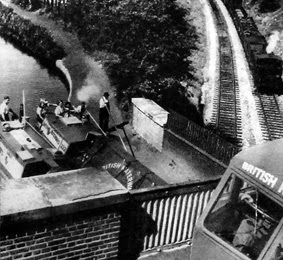 The bridge has been used in carefully posed promotional photographs by several organisations. The picture shows it being used by British Railways, British Waterways and British Road Services.
The bridge has been used in carefully posed promotional photographs by several organisations. The picture shows it being used by British Railways, British Waterways and British Road Services.
The bridge has been designated a Scheduled Ancient Monument.
Battlefield Archaeology Jim Nelhams
A number of HADAS members attended a talk on 16th June organised by the Battle of Barnet Partnership and given by Sam Wilson of Huddersfield University. Sam is the Archaeological Supervisor of the project.
Battlefield Archaeology, Sam explained, is a sub-set of conflict archaeology dealing in particular with the sites of battles or in some cases, potential battles. It is a relatively new discipline which had developed following the invention of metal detectors. It had been successful in the mid-1980s in America when investigating the site of the Battle of the Little Bighorn, with the detectors finding lots of cartridge cases and other military items. Newer technology such as ground penetrating radar and LiDAR (Light Detection and Ranging) from aircraft, adding to aerial photography, helped provide topographical information not always apparent at ground level.
The discovery of a battle site should bring together historical documentation, with topographical
information and the discovery of battlefield remains, largely metallic in nature. With the battle of Bosworth Field, the process of proving that the accepted site was incorrect, and locating the correct site had taken about 5 years. The conclusion had been confirmed by a cluster of over 30 cannon balls. These were largely lead – iron does not normally last for long periods in the ground. Also, there is so much “modern” iron on fields that detectorists set their machines to ignore it. Once the site had been found, all the information came together.
As far as the Battle of Barnet is concerned, it is still early days. Very little has been found that points to a particular location, but some agricultural land can only be inspected outside the growing season. The current funding runs to this August, but it was hoped that more could be found. So watch this space ….. or maybe that one.
The Abbey Folk Park, New Barnet Bill Bass
This site bounded by Park Road and Heron Rise has a fascinating past being founded by Rev John Ward in 1934. He created a complex mixture of museum, building reconstruction, experimental archaeology and ethnography. It is said to be one of the earliest ‘open air’ museums of its kind.
Based around an existing Victorian Villa called Hadley Hall the most notable ‘reconstruction’ was a medieval tithe barn moved from Birchington-on-Sea, Kent (this was converted into a chapel which still stands). Other areas in the park contained an African village, a prehistoric village complete with roundhouses, smithy, Roman villa and Witches Cottage amongst others. Other structures housed the museum collection of some 90,000 objects.
The park ran successfully until 1940 when questions were asked how the museum was being run – there was a semi-monastic, religious and mystical feel to it. After a court case the collections were sold to pay costs, Ward took his community to Cypress where he died in 1949, and the park was sold on to become the Abbey Arts Centre. Many of the objects were scattered; Liverpool Museum holds a number of Tibetan figurines known from Ward’s collection. Remarkably 4500 objects made their way to Australia and now form the Abbey Museum of Art & Archaeology, Queensland, opened in 1986.
The New Barnet site has become subject to planning applications for 3-4 two-storey dwellings on the southern half of the park, the northern half with the chapel, villa and cottages is unaffected. The latest of the applications dates to May/June 2016.
For more information see ‘John Ward: The Man who Collected Houses’, British Archaeology May/June
2016. Or see the planning application 16/3318/FUL, heritage statement, on Barnet Council’s website.
Report of the June 2016 post-AGM Lecture. The Rose Discovered and the Rose Revealed given by Harvey Sheldon. Written by Liz Gapp and Simon Williams
Harvey Sheldon, who is president of HADAS, initially gave a brief review of his involvement with the Rose theatre excavation. Firstly, he was employed by the Department of Urban Archaeology of the Museum of London, then ultimately he became chairman of the Rose Theatre Trust formed in 1989, which means he has more than 25 years involvement with the Rose.
Whilst this year is widely known to be the 400th anniversary of Shakespeare’s death, what is less known is that it also is the 400th anniversary of the death of the man who built the Rose in 1587, namely, Phillip Henslowe, who died on 6 January 1616.
With a background slide of the uncovered excavated Rose foundations, Harvey gave us the history of the excavation, which has proved to be very significant to subsequent excavations. He also described the fight to preserve it for future generations, preventing its destruction by the builders.
The excavation started in 1988. An office building, Southbridge house, was to be replaced, and the developers acceded to requests for excavation. Harvey showed us various maps on which the Rose’s location is indicated. As he said, nowadays there is much more initial investigation of paper records to evaluate whether excavation will reveal anything significant. It was fortunate this was not done so rigorously back in 1988 as maps showing the area at this time had the Rose at the opposite end of the Rose alley. The discovery of the Rose foundations was considered so important at the time, when planning laws did not require archaeological considerations to be taken into account, that Mrs Thatcher subsequently, as a direct result of this excavation, introduced the requirement, which included funding, for all subsequent building development projects.
Originally a very short period was allocated for the Rose excavation. Leaving it at the end of the allocated time would have meant that all traces of the Rose would have disappeared unrecorded. Prior to excavation no physical evidence had ever been discovered – no shape, plan, or structural details of any theatre. Some Victorian maps provided the only extant archive, which as previously mentioned was not always accurate.
Within 4 weeks, segments of the wall appeared, not at right angles, but showing a polygonal shape. By February 1989, the details revealed had caught public interest. What had been uncovered were the gallery walls, two phases of the stage including a 1592 alteration to enlarge the theatre, a floor sloping towards the stage, and a 14 sided polygonal shape for the original theatre before enlargement.
The campaign and publicity accompanying this excavation radically altered the excavation with more time and money required. It was felt that the physical remains deserved more than just recording. Amongst other publicity was an article dated 15 February 1989 in the Times. An added dimension to the campaigning was the involvement of many famous actors who felt that the history of the Rose in the theatre world made it very important to preserve it. After Sir Lawrence Olivier’s last public utterance, reported in The Times on 12 May 1989, which included his battle cry of ‘God for Harry and the Rose’ – he died a few weeks later – and a star studded campaign, the campaign climaxed with Dame Peggy Ashcroft leading a candlelit night vigil on the Rose site. On the following day Mrs Thatcher’s Government announced a £1million grant to save the Rose. The government announced one month’s moratorium on the building, the result was that the developer agreed that the first floor of the new building would be allocated to display artefacts found during the Rose excavation. These included broken money boxes for the takings and the broken hazel-nut shell surface of the internal drainage ditch for the roof run-off into the standing area. The nutshells may have been a remnant of soap making. All these uncovered artefacts have certainly pushed forward knowledge of the Elizabethan Theatre.
Before the building began the site excavation had to be covered over in sand and concrete, both to protect it from potential damage from the building process and also because as the site, which was originally a wetland area, began to dry out the foundations were being damaged, so it was necessary to reinstate the damper environment.
June 1989 marked the end of the museum’s involvement, when it devolved to English Heritage. In February 1992, the site was granted ancient monument status, so giving it protection. It was then left until 1999, when a temporary exhibition was mounted to highlight the theatre footprint in the basement, and to display the plans being drawn up for its future. Today, it is open for modern tours on Saturdays. The area which had declined in the 1960s from its late 16th century roots is now, partly thanks to Tate Modern and other local development, returned to its former vibrancy.
Opening the doors of the Rose displays helps with funding for the Heritage Lottery Fund plan to build a visitor centre which Southwark Council planning department have approved. This will cost £8million, but to qualify for the grant needs a minimum lease of 15 years. Since its construction, the Rose Court building has passed through four owners. The Rose trustees had been negotiating for 18 months with the latest owners, Ho Bee, when they announced plans to sell the building, so negotiations are currently on hold. The trustees are now approaching the government to get pressure to force the lease through.
Harvey then showed us a series of slides showing the progress of the excavation and the campaign to raise public profile. This also highlighted the importance of the Rose which was associated with both playwrights Shakespeare and Marlowe, and the actor Edward Alleyn.
Papers from Henslowe’s extensive accounts, with connection to the Rose, Marlowe and Edward Alleyn,
Henslowe’s son-in-law, were endowed to Henslowe’s foundation, Dulwich College. Included in these papers are references to ‘turned’ balusters (for the galleries) like the one of fine oak that was found intact on the ‘Globe’ site.
The slides included images from late 1988 when the excavation started, showing early stages of demolition; images from April 1989 with the whole (2/3) of the Rose building foundations uncovered, showing the drip trench for the gallery and the change to the theatre slope. (Only 2/3 was excavated as the rest was not in the excavation area.)
There were many images showing the actors involved in the publicity campaign on the site, including Dame Peggy Ashcroft’s sit-in. From 2000 to 2001, Susanna York put on a play to raise funds for the Trust, and there have been other plays since. There were various images of this. Images showing mock-ups of the future planning ideas which will happen if the lease issue for the building is resolved were displayed.
There is also now an opportunity to excavate the last 1/3 of the Rose foundations, to confirm (or otherwise) that its shape is as surmised from the 1988/9 excavation, which will come under the same protection as the rest of the current foundations.
Upgrading Listed Building descriptions
The National Heritage for England (NHLE) contains nearly 400,000 entries (predominantly Listed Buildings) available online from Historic England. However, the list lacks images and many of the entries, particularly older list descriptions are very brief and out of date.
Historic England is aware that there are many individuals and organisations that have a good deal more information about these buildings and sites than available in the description in the NHLE entry. To bring this knowledge together with The List, Historic England has launched Enriching The List (ETL) crowd- sourcing initiative to open up the NHLE to additional information and images from its users. This additional content appears after the list entry and separated from it so it is clear that it is not part of the statutory description. Users can upload additional information, up to four images per post, and provide links to other online sources or images. These are then moderated before being published to ensure that they meet the terms and conditions.
Following a trial period, the project was launched on 7th June and at the time of writing over 2,500 contributions have been published, including over 3,000 images. The feedback from users so far has been overwhelmingly positive with users saying how easy it is to submit information and photographs and what a great idea they think it is.
Civic societies contain a vast resource of knowledge about the heritage of their local areas, both as organisations and through their individual members. Historic England is inviting the civic movement to help them enrich The List, and individuals can sign up as volunteers online.
You can find out more about the project including how to take part and some of the content uploaded so far at www.historicengland.org.uk/etl. If you have any queries or feedback please email EnrichingTheList@HistoricEngland.org.uk.
The Forth and Clyde Canal (and the Union Canal) Jim Nelhams
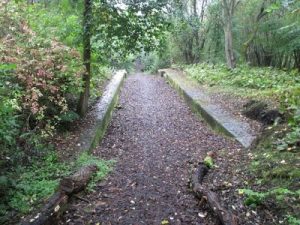 Some HADAS members may have noticed our interest in canals. The long HADAS outings have often included a stop at a canal, and sometimes a ride on a narrowboat. We have been taking holidays on canal boats for over 30 years (not every year) and are very interested in their history and their place in industrial archaeology. This year, we ventured north of Hadrian’s Wall for six days on these Scottish canals.
Some HADAS members may have noticed our interest in canals. The long HADAS outings have often included a stop at a canal, and sometimes a ride on a narrowboat. We have been taking holidays on canal boats for over 30 years (not every year) and are very interested in their history and their place in industrial archaeology. This year, we ventured north of Hadrian’s Wall for six days on these Scottish canals.
The first act of parliament relating to this canal, received the royal assent on the 8th of March 1768, making it very early as British canals go, and the first sea to sea canal in the world. It opened in 1790 and ran from Bowling sea basin on the River Clyde to the River Carron which flows into the Firth of Forth, with a short spur into Glasgow. To accommodate seagoing craft, it is wider than most canals and once operated steamboat trips. For much of its length it follows close to the Roman Antonine Wall.
The Union Canal joined the Forth and Clyde at Falkirk, giving access to Edinburgh. This is a contour canal closely following the 240 feet contour line for over 30 miles, so that the only locks, 11 of them, were in the last half mile where it dropped to join the Forth and Clyde. One wonders at the surveying that made this possible.
As with most canals, the two fell out of use, and both were closed in the early 1960s. The construction of the M9 motorway blocked the end of the canal at the eastern end, and on the Union Canal, most of the locks were filled in and housing built on the reclaimed land. So when volunteers wanted to restore and re-open both canals, they had real challenges to face.
Disused canal lock
The Forth and Clyde canal was the easier, though it needed a new exit to the Carron River, and two other locks had to be replaced. Fortunately, as part of the Millennium celebrations, Lottery funding was made available to help with both canals.
On the Union Canal, a new stretch of canal was excavated, with a staircase of two new locks, a new tunnel, the first new canal tunnel in Britain for over 100 years. To move boats the 80 feet between the tunnel and the Forth and Clyde, a magnificent new construction known as the Falkirk Wheel was opened by the Queen in 2002. The Falkirk Wheel has become a tourist attraction with coach loads arriving to ride in trip boats on the wheel and through the tunnel.
The eastern end of the Forth and Clyde is now guarded by the two largest equine statues in the world, completed in 2013, and about 100 feet tall. Known as The Kelpies, the horses’ heads are based on mythical creatures with the strength of 10 horses and modelled on two Clydesdale horses, the type that hauled the canal barges. The construction is of sheet steel sections, which at night are lit from the inside in changing colours. Two smaller copies, a mere 5 foot high, are at the side of the Wheel.
One of the Kelpies.
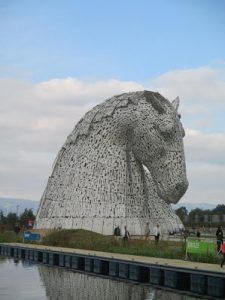 Tourists are also served at the wheel by an appropriately stocked shop, selling among other things bottles of a local brew branded as “Wheel Ale”!
Tourists are also served at the wheel by an appropriately stocked shop, selling among other things bottles of a local brew branded as “Wheel Ale”!
Other Societies’ events, compiled by Eric Morgan.
Thursday 8th September, 8pm. Battle of Barnet Project. Pennefather Hall, Christ Church, St Albans Road, Barnet EN5 4LA. Altars to Apps: commemorating and interpreting UK battlefields across 1000 years. Talk by Simon Marsh (Battlefields Trust). Tickets on door £5 including refreshments.
Friday 9th September, 7.45pm. Enfield Archaeological Society. Jubilee Hall, Parsonage Lane,, Enfield EN2 0AJ. Life in Post-medieval Southwark: finds from recent excavations. Talk by Jacqui Pearce (MOLA & HADAS course tutor).
Monday 12th September, 3pm. Barnet Museum and Local History Society. Church House, Wood Street, Barnet (opposite museum). Chipping Barnet War Memorial. Talk by Dennis Bird (HADAS member). Visitors £2. Email:
enquiries@barnetmuseum.org.uk.
Tuesday 13th September, 7.45pm. Amateur Geological Society. The Parlour, St Margaret’s Church, Victoria Ave N3 1BD (off Hendon Way). Virtual Fossils: soft bodied sensations from the Silurian. Talk by Prof Derek Siveter.
Friday 16th September, 7pm. COLAS. St Olave’s Parish Hall, Mark Lane, EC3R 7LQ. The King’s Observatory: the quest for Shene charterhouse & the search for an old latrine. Talk by Bob Cowie (MOLA). Visitors £2.
Friday 16th September, 7.30pm. Wembley History Society. English Martyrs Hall, Chalkhill Rd, Wembley HA9 9EW (top of Blackbird Hill). Dirty London. Talk by Pat Dutson. Visitors £3. Refreshments 50p.
Saturday 17th September. Barnet Museum and Local History Society. Coach outing to Rochester. For details please contact Pat Alison at 37 Ladbroke Drive, Potters Bar EN6 1QR. Telephone 01707 858430 or Barnet Museum on 020 8440 8066. Email: enquiries@barnetmuseum.org.uk.
Saturday 17th & Sunday 18th September. London Open House Weekend. Free access to over 800 buildings. Details at www.openhouselondon.org.uk. Including the Friends of Brompton Cemetery. Guided tours of the chapel starting at 2pm on both days.
Tuesday 20th September, 6pm. Gresham College at the Museum of London. 150 London Wall EC2Y 5HN. Queen Victoria. Talk by Prof Vernon Bogdanor. FREE. Also Wednesday 21st September, 1pm. The Cradle of Stonehenge? Blick Mead – a Mesolithic site in the Stonehenge landscape. Talk by Prof David Jaques.
Sunday 25th September to Sunday 2nd October. Barnet Borough Arts Council. The Spires, High Street, Barnet EN5 5XY. Arts and Information Exhibition (including HADAS).
Wednesday 28th, September, 7.45pm. Friern Barnet & District Local History Society. North Middlesex Golf Club, The Manor House, Friern Barnet Lane, N20 0NL. The Cinema Museum. Talk by Martin Humphries. Visitors £2. Refreshments & bar.
Thursday 29th September, 8pm. Finchley Society. Outreach meeting in East Finchley (please see Sept/Oct Finchley Society newsletter for details). Visitors £2.
Until Friday 30th September. Stephens House & Gardens (Avenue House). Hospitals for Heroes. FREE summer exhibition of Avenue House as a VAD hospital during WW1 and as the RAF Central Hospital from 1919. Open Tues/Wed/Thurs 1-4.30pm. Sat & Sun 12-4.30pm.
No. 544 July 2016 Edited by Mary Rawitzer
HADAS DIARY
Monday 19th – Friday 23rd September. HADAS trip to Bradford-on-Avon
Tuesday 11th October 2016, 8pm. Women in Medieval London, Lecture by Professor Caroline Barron
Tuesday 8th November 2016, 8pm. The Cheapside Hoard. Lecture by Hazel Forsyth
All the lectures are held at Stephens House & Gardens (formerly Avenue House), 17 East End Road, N3 3QE, starting at 8pm, with tea/coffee and biscuits afterwards. Non-members are welcome (£1.00). Buses 82, 125, 143, 326 & 460 pass nearby. Finchley Central Underground Station (Northern Line) is a short walk away. Reminder:
Stephens House & Gardens (Avenue House) is hosting its Annual Summer Fête 17th July 12-5pm Live music, fun & games, stalls, food & drink. Free admission. HADAS will have a table
Membership Renewals – another reminder Stephen Brunning
Many thanks to everyone who has already paid their subscription. If you intend to renew this year and have not yet done so, I would be grateful to receive payment by 22nd August 2016 at the following rates: £15 (Full), £5 (each additional member at the same address), £6 (Student). My address is on the last page of this newsletter.
It is not necessary to return the renewal form enclosed with the March newsletter. A piece of paper with your name, postal address, telephone number and email address (if applicable) will suffice. I will then be able check the details we hold are still correct. It would also be helpful if you could indicate your willingness to receive the newsletter by email. This helps to keep our costs to a minimum. Thank you.
HADAS Course 2016/2017 Don Cooper
For the academic year 2016/2017 HADAS is again running its post-excavation course, this year entitled “Finds in Focus”. This course will concentrate on re-analysing, identifying and recording finds from the Birkbeck excavation at Lant Street in 1999, as well as re-boxing, re-bagging and relabelling the artefacts to bring them up to Museum of London archive standards.
The course will be tutored by Jacqui Pearce BA FSA MIfA and will take place on Wednesday evenings from 18.30 for two hours at Avenue House, 17 East End Road, Finchley, N3 3QE. There will be 22 sessions with a term break in December. The cost of the course will be covered by a donation to HADAS of £295. The course starts on Wednesday, 28th September 2016.
There are up to four places remaining on the course. If you would like to join please apply to Don Cooper at the contact details on the back page. The places will be allocated on the basis of first come first served. Do come and join us.
University Archaeology Short Courses Free Online
Simon Williams has alerted us to a couple of interesting courses. Both started on June 20th, but it should be possible to catch up, at least with the first one. And both are FREE.
From Southampton University: Archaeology of Portus: Exploring the Lost Harbour of Ancient Rome – How ancient artefacts, written evidence, excavation and digital technologies are transforming understanding of this harbour. (The Roman harbour city of Portus lay at the heart of an empire that extended from Scotland to Iraq. Established by Claudius and enlarged by the emperor Trajan with spoils of the Dacian wars, the port was the conduit for everything the city of Rome required from its Mediterranean provinces: the food, and particularly grain, that fed the largest urban population of the ancient world, as well as luxuries of all kinds, building materials, people and wild animals for the arena. Although the site lies in ruins, it has some of the best-preserved Roman port buildings in the Mediterranean, and this will cover interpreting these and the finds discovered within them using primary research data and the virtual tools of the archaeologist.
This course lasts 6 weeks. Approximate minimum time commitment: 4 hrs/week. See https://www.futurelearn.com/courses/portus
From the University of Reading: Archaeology: from Dig to Lab and Beyond, exploring exciting discoveries in the Vale of Pewsey, with a virtual field trip charting the university Field School’s month-long excavation in the Vale, a relatively untouched site compared to its world-famous neighbours, Stonehenge and Avebury. And charting the progress from field to lab.
No prior experience of archaeology is needed. This course is designed for anyone interested in studying an archaeology degree at university, but anyone with an enthusiastic interest in archaeology is very welcome too. This course lasts 2 weeks. Approximate time commitment: 3 hrs/week. https://www.futurelearn.com/courses/archaeology
HADAS Annual General Meeting Tuesday 14th June 2016 Jo Nelhams
The 55th Annual General Meeting was held on Tuesday 14th June 2016 at 7.45pm. The meeting was attended by 30 members and 1 guest which was somewhat fewer than last year but apologies were received from a further 28 members whom I thank for responding to the request in the Newsletter.
The Chairman, Don Cooper opened the meeting and welcomed all those present, including the President, Harvey Sheldon. The President was then invited to take the chair to conduct the business of the meeting.
All the officers were prepared to stand again for election, and were unanimously returned to office:
Chairman: Don Cooper, Vice –Chairman: Peter Pickering, Hon. Treasurer: Jim Nelhams, Hon. Secretary: Jo Nelhams and Hon. Membership Secretary: Stephen Brunning
The six current Committee Members were also prepared to stand again and were duly unanimously elected. They are Vicki Baldwin, Bill Bass, Roger Chapman, Eric Morgan, Andrew Selkirk and Sue Willetts.
The Secretary reported that Sheila Woodward, a long standing member, was at present in hospital and Dot Ravenswood was in a nursing home.
The Treasurer registered his concerns as to the future of the Society due to the lack of volunteers to help with the organisation. The present occupants of the offices have served for a number of years. He also made members aware that their subscription barely covered the cost of the Newsletters each month and that we were greatly indebted to the legacy of Ted Sammes. The cost of the AGM alone is over £200. It would serve the society well if existing members could recruit some new members.
The Chairman reported that HADAS will again be digging at Clitterhouse probably late July.
The Finds Group continues to thrive and will be studying the finds from Lant Street.
Hendon Baptist Church has offered the use of their hall free of charge for HADAS to host an open day for people to bring in finds and also see some of the local finds which HADAS has in its possession. The proposed date is Saturday September 3rd.
The Vice- Chairman was also thanked for all his work scrutinising planning applications and responding to the need to set archaeological conditions.
The meeting closed at 8.10pm. The Chairman then invited the President Harvey Sheldon to deliver his talk on the Rose Theatre ‘The Rose discovered and the Rose revealed’. This talk will be reported in a future Newsletter.
ST ANDREW, TOTTERIDGE Elizabeth Burling
Totteridge is situated on the ridge of high ground between the valley of Dollis Brook and its tributary, Folly Brook, in the southern extension of Hertfordshire into Middlesex.
The curved edge of the churchyard may indicate that the first church built here was on a site already well-used by local people since ancient times. That this may have been a sacred site is strengthened by the presence in the churchyard of an ancient yew tree (pictured below).This is estimated to be between 1000 and 2000 years old and may be the oldest tree in the Greater London area. It may be older than the first church on the site, which is mentioned in a document dated 1250AD, recording that Totteridge Church belonged to St Etheldreda’s, Hatfield.
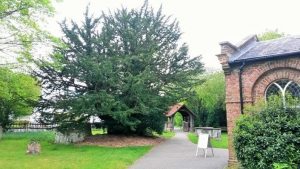 St Etheldreda, daughter of Anna, King of East Anglia, was born at Exning near Newmarket in 636AD. She founded a monastery at Ely, which had been part of her dowry, and later retired there. Her shrine was at Ely Cathedral but was moved to the chapel of the London residence of the Bishops of Ely at Ely Place, off Charterhouse Street, Holborn. This chapel, now known as St Etheldreda’s Church, is a rare survivor in London, having been constructed between 1250 and 1290 during the reign of King Edward 1. The attached gardens were said to produce the finest strawberries in London and are mentioned in Shakespeare’s Richard III.
St Etheldreda, daughter of Anna, King of East Anglia, was born at Exning near Newmarket in 636AD. She founded a monastery at Ely, which had been part of her dowry, and later retired there. Her shrine was at Ely Cathedral but was moved to the chapel of the London residence of the Bishops of Ely at Ely Place, off Charterhouse Street, Holborn. This chapel, now known as St Etheldreda’s Church, is a rare survivor in London, having been constructed between 1250 and 1290 during the reign of King Edward 1. The attached gardens were said to produce the finest strawberries in London and are mentioned in Shakespeare’s Richard III.
It was King Edward 1’s grandfather, Saxon King Edgar, who seems to have given Hatfield (along with Totteridge) to the Abbot of Ely when the monastery was refounded. So this is why the church at Totteridge was initially dedicated to St Etheldreda, the name gradually being shortened to St Audrey. The change of dedication to St Andrew may have been at the time of the Reformation when biblical saints were more popular. It is interesting to note that in manuscript form, Audrey and Andrew can be quite similar!
In 1650 it was suggested that Totteridge be detached from Hatfield but this did not actually take place until 1892, the new parish then containing 785 inhabitants.
The Churchwarden’s Accounts and Vestry Minutes began in 1613. Various repairs carried out to the fabric of the building are recorded, including those resulting from a week-long storm in November 1703 which swept away the first Eddystone lighthouse and demolished hundreds of windmills. The church weathervane is dated 1706 and it is possible that the original was destroyed in this gale.
The church itself had to be rebuilt in 1790, apparently by architect William Ketteridge. It is a plain brick building with a weather-boarded bell turret dated 1706 which had come from the previous building.
Inside the church are a number of memorials which refer to members of the family of the great uncle of Samuel Pepys, diarist. Sir Lucas Pepys was physician to George III and president of the Royal College of Physicians.
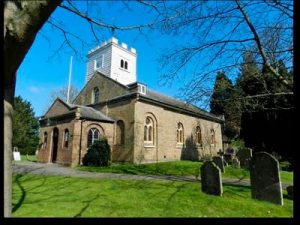 The lych gate to the Churchyard dates from 1930 and was erected in memory of Lady Barrett of Totteridge Park. This 18th century house is located on the site of what was a residence and private chapel belonging to the Bishop of Ely in the 14th century.
The lych gate to the Churchyard dates from 1930 and was erected in memory of Lady Barrett of Totteridge Park. This 18th century house is located on the site of what was a residence and private chapel belonging to the Bishop of Ely in the 14th century.
Parish Records
Totteridge parish records dating from 1546-1966 are held by Hertfordshire Archives and Local Studies, County Hall, Pegs Lane, Hertford, SG13 8EJ.
Transcripts of the baptisms 1570-1837, marriages 1570-1836 and burials 1570-1837 are available at Barnet Local Studies Centre, Hendon Library (first floor), The Burroughs, London NW4 4BQ.
Images of baptisms 1546-1903, marriages 1754-1789 and burials 1570-1937 are available on payper-view site FindMyPast.
London Westminster & Middlesex Family History Society has produced a fiche of St Andrew’s Memorial Inscriptions: NMP 29 includes St Andrew MIs & the burial register plus the Dissenters Chapel, cost £1.50. Only 3 left. See Dec. METROPOLITAN for details if you would like one.
The Church has detailed plans of the burial ground and if you would like to know the position of a particular grave, you can email Richard Peart on: rwpeart@care4free.net for assistance. There is a statutory fee for this service.
Sources:
Ancient Yew Group: http://www.ancient-yew.org/s.php/frequently-asked-questions/2/2#
St Albans History: http://www.stalbanshistory.org/documents/1901_02_05_.pdf
Totteridge Church: http://www.totteridgechurch.org.uk/#!history/c1u7q
This article first appeared in METROPOLITAN, the journal of the London Westminster & Middlesex Family History Society.
Join the Clitterhouse Farm Dig 2016 Bill Bass
Below are more findings from the Clitterhouse Farm excavation last year. Now HADAS has obtained permission to dig there again, around Wednesday 20th to Wednesday 27th July (to be confirmed). If you are interested in taking part please contact myself (bill_bass@yahoo.com, 020 8449 5666) or Don Cooper (details back page). Further details will be sent later via email.
Excavations at Clitterhouse Farm, Cricklewood by HADAS. by Bill Bass and The Fieldwork Team
(Part 4, Report on the Animal Bone and Marine Molluscs and some small finds photographs)
Site code: CLM15, Clitterhouse Farm, Claremont Road, Cricklewood, NW2 1PH NGR: TQ 23689 86819, SMR: 081929, Site investigated July/August 2015.
For background on this project please see HADAS Newsletters 539 (Feb 2016), 542 (May 2016) and 543 (June 2016).
Geraldine Missig has kindly supplied this report on the Animal Bone and Marine Molluscs from Clitterhouse Farm. Reference should be made to Newsletter 542 (May 2016) for trench and context locations. A comprehensive database of the bone and mollusc finds, also by Geraldine, lies with the archive.
Records as far back as 1584 describe Clitterhouse Farm as a working farm, which continued operating in different configurations up to the early 20th century. In July 2015, HADAS opened three trenches on the old farm’s grounds at Claremont Road, London NW2 1PH, (CLM15). A small assemblage of 78 identified animal bone specimens weighing 1449g, and 20 marine molluscs fragments weighing 158g was recovered. In addition there were 57 unidentified fragments which weighed 262g. They occurred only in contexts (T1/005) and (T2/002) and consisted of 43 cattle – sized fragments weighing 237g, and 14 sheep/goat sized pieces weighing 25g.
Method
The animal bone fragments were identified by reference to the bone collection at Birkbeck, University of London and recorded on a spreadsheet as to species, anatomical part, side, state of fusion (following Schmid 1972), proportion of bone present, weight, and any modification such as dog or rodent gnawing, burning or butchery. The marine molluscs were also counted, weighed, identified, and recorded. Oysters valves were separated into left and right; their condition too friable to reliably note cut marks.
Each identified specimen was allocated a specimen number (SpNo) and where two pieces joined together they were counted as one.
Only sheep/goat teeth were recovered. However, they were all too damaged to apply in any detail the Payne (1973) age attribution to their wear stages save to note that one was mature.
Sheep and goat (caprine) bones are morphologically similar though some bones display features which can distinguish between the two. These characteristics have been described by Boessneck (1969) and applied to the relevant caprine bones in CLM15. This was possible only in two instances, a distal humerus in (T1/005) and a distal metacarpal in (T2/002), both of which were that of sheep.
Findings
Marine Molluscs
Small numbers of marine molluscs, in the form of nineteen oyster valve fragments and one large whelk shell, were present in all of the contexts except (T1/005), a context whose bone was noticeably poorer preserved than any of the others. The abraded state of its bones prompts the concern that should any oysters have in the past been within (T1/005), they may by now have been reduced to nothingness. The edges of oysters in the contexts with better preserved bones are disintegrating into powder, extinguishing at the same time any traces of any marks that would have been left on the shell if they had been prised open.
The nineteen valve fragments can be broken down into twelve right, the flatter, thinner half, and seven left, the curved, deeper part in which the meat of the oyster rests and is served. Four of the right valves weighing 10g and the whelk weighing 11g came from undated contexts recovered from the topsoil. The remaining oysters came from the contexts dating between 1800 and 1900, according to the pottery sherds retrieved with them. Contexts (T2/002) contained two left and two right valves while (T3/005) had six left and six right. Although a surprisingly even distribution of left and right valves, the fragmented state of many of the valves precluded the identification of any pairs.
Animal bone recovered from undated contexts
The three (131g) animal bone fragments found in the topsoil contexts, (T1/002) and (T2/001), were small, butchered, dog-gnawn fragments of cattle and sheep/goat meat bearing bones. Their reduced size and butchery marks suggest human processing. Indeed, the sawn off unfused head of a young, less than 4 years, cattle femur resembles the butchery waste of an awkward, unwanted portion of a good quality meat bone . This is supported by the presence in the group of four right oyster valves, the flat side removed probably in preparation before service. Dog gnawing on the fragments and their presence near the ground surface in the topsoil suggest very little effort was made to properly dispose of these, following use at some unknown time.
Animal bone recovered from contexts dated 1800 -1900
Trench 2 was located against the wall of the existing farm complex in an attempt to discover its relationship with the formally laid gardens depicted in that area on plans of the farm complex after 1816. Trench 3 was placed approximately 15m northeast of it in a bid to pick up any evidence of a body of water or an old ‘moat’ which was known to have at least partially encircled the farmhouse up till the late 19th century.
Although coming from these different trenches, two of the contexts, (T2/002) and (T3/005), share a similar soil composition, firm grey/brown silty sandy clay, and have similar OD levels. The artefacts in the contexts include not only animal bone but pottery, glass, worked bone, clay pipes, iron and building materials, an assortment of dumped material. From the pottery sherds found within each context, similar dates of between 1800 and 1900 have been assigned them.
The animal bones in each trench, while differing in some details, appear mainly to be the products of butchery waste with a bit of slaughter remains. However, as the fragments are few, caution should be exercised before regarding them as representative of what was deposited in the surrounding ground or of the activities that were taking place there at the time. Corroboration with greater numbers would be needed.
Of the twelve fragments in (T2/002), sheep/goat is predominant at 67%, with cattle at 17%, and pig and domestic fowl each at 8%. In this context was one of the bones with features capable of distinguishing sheep from goat, a distal metacarpal which was that of a sheep. There is evidence of butchery on 54% of the fragments, although 75% of the fragments in the group amount to only 25% or less of the original bone. The disposal of the bone waste appears to have been effectively managed as only 25% exhibit dog gnawing marks. Many of the fragments are those parts of a bone which are removed before consumption, making it likely to be waste following butchery. A broken upper second molar of a mature sheep/goat suggests in addition slaughter waste.
Of the thirteen fragments in (T3/005), cattle is predominant at 69%, with pig at 23%, and sheep/goat at 8%. There is a level of butchery equal to that in (T2/002); however less fragments are processed to small pieces with only 46% being 25% or less of the original bone. This suggests that the purpose of the butchery may have been dismemberment with two unfused calf’s skull fragments as slaughter waste.
Sixty nine percent of the fragments in (T3/005) are from small, young cattle and pig, each a minimum number of one individual. An unfused acetabulum (pelvis) indicates a calf less than six months, and a complete pig radius (lower foreleg) unfused proximally and distally points to an animal less than a year old, though its small size would suggest an age more in the middle of that range. Dog gnawing marks were low at 15%.
The excavators considered it likely that the ‘moat’ feature had been located as the base of (T3/005) appeared to be a ditch formation falling sharply down to natural in the place where the old ‘moat’ was thought to have been. Proximity to water would have been useful if the area had been used for the slaughter of animals and the dismemberment and processing of carcasses as possibly hinted at by the animal bone in the two contexts. Equally, a nearby body of water is a convenient place to dispose of unwanted things.
Animal bone recovered from a context dated early 17th to mid/late 17th century
Trench 1 was located approximately 13m west and slightly south of Trench 2. It was placed in an area thought to be near to the site of an old barn and adjoining stable mentioned on an 18th century map as requiring repair or demolition.
While higher layers in the trench contain pottery with later dates such as Surrey/Hampshire border ware (1550 -1700), Frechen stoneware (1550 – 1700) and post medieval red ware (1580 – 1900), the animal bone was found in the deepest context, (T1/005), lying over natural. With it were loose worn cobbles, at least four sherds of jar bases of Raeren stoneware (1480 -1610) and nine sherds of tinglazed ware type A, (1612 – 1650). All were sealed beneath a beaten chalk floor 5 – 8cm thick (T1/007) which spanned the extent of the trench suggesting that the animal bone, pottery and cobbles of (T1/005) were a make-up layer for the floor (T1/007).
This type of floor may indicate a working surface. An adjoining ‘old barn and stables’ are depicted on a c.1790 – 1816 plan with the stables segment in the vicinity of Trench 1 raising the likelihood that (T1/007) may be part of the floor surface of the ‘old stables’. Even today a crushed chalk floor is thought a good base for livestock as it is warmer and kinder to the animals’ feet than concrete. It is also absorbent, drains well keeping quarters dry and neutralizes odours.
As mentioned above, the bone fragments found within the group were in poor condition, possibly as a consequence of the type and volume of liquids seeping through the chalk floor. Their surface was abraded masking some marks. Of the fifty identified fragments in (T1/005), cattle was predominant at 62%, with sheep/goat at 22%, domestic fowl at 16%. The other bone capable of distinguishing between sheep and goats was in this context and it was the distal humerus of a sheep.
The eight fragments of domestic fowl comprised the wing, leg, and small piece of breast of a minimum number of one individual. With no marks, save those of recent damage, their former use is uncertain, possibly the remains of consumption, possibly those of food preparation. As domestic fowl is processed in a different manner than cattle and sheep/goat their fragments have been left out of the following enumerations. There was evidence of butchery on 74% of cattle and sheep/goat bones, and 69% of these fragments amounted to 25% or less of the original bone. Dog gnawing of the specimens was minimal at 2%, though the bones’ poor condition may have concealed some teeth marks. There was evidence of one incident of rodent gnawing. These heavily processed fragments were predominantly butchery waste, a combination of parts removed in the preparation of meat cuts, and unwanted animal footbones – carpal, tarsal, the metapodials, and phalanges.
A fragment of cattle radius (lower forelimb) and three cattle metapodials showed evidence of additionally being worked waste. These worked metapodials were highly fragmented with the three bones formed from nine pieces. Metapodials were frequently used in bone working as they are strong and well shaped for working.
Present also was a small group of butchered cattle skull fragments, an indication of animal slaughter. The waste nature of the bones in (T1/005) would be consistent with their final function as a probable levelling layer for a floor.
Conclusion
Although the CLM15 bone assemblage is a small sample, it has, on the whole, been a consistent one with the bone fragments predominantly the consequence of butchery with some slaughter waste. Additionally, the earliest dated context, (T1/005), includes worked waste. The low quantity of bone fragments in the dated contexts in Trenches 2 and 3 together with the variety of other discarded materials indicate that they were not a regular dump sites while the composition and location of the Trench 1 deposit suggests that it was a makeup layer for the chalk floor. Apart from the slim presence of domestic fowl and oysters, domestic refuse has been absent from the assemblage suggesting it was disposed of in a different place.
Cattle was the favoured species making up 61% of the whole group, with sheep/goat following at 26%, domestic fowl at 11%, and pig at 2%. There was no evidence of any horse bone. Although as a whole cattle was predominant, the two contexts in Trench 2 featured mainly sheep/goat fragments. Dog gnawing of the bone fragments in all the dated contexts was infrequent indicating an effective disposal of waste material.
While some early maps of the area excavated show it as ‘general land’, or ‘a clear area’, the land was part of a busy, functioning farm and the uses suggested by the recovered animal bone fragments is consistent with that.
In the late 18th/early 19th century Clitterhouse farm was reorganized with the demolition of old buildings and the construction of new ones in a different layout. The early to mid/late 17th century dates for the pot sherds included with the animal bone under the chalk floor in Trench 1, however, place them contemporary with the old farm, predating the farm’s rearrangement. The chalk floor with its likely makeup layer of pottery, worn cobbles and animal bone fragments (including worked waste) suggests a link to the ‘old stables’ shown on the c.1790 – 1816 plan in close proximity to the site of Trench 1.
The animal bone from dated contexts in Trench 2 and 3 was recovered from disturbed areas. The 1800 to 1900 date range for the artefacts retrieved with the bone fragments is wide, beginning with the start of the farm’s reorganisation c.1800, carrying through to its completion c.1816, and beyond. This allows only a small window of time, the early years of the 19th century, during which the dumped deposits of Trench 2 and 3 could be a consequence of the modernisation of the old farm and no evidence of that was found. Whether or not there was a connection to the general upheaval of the renovations, the Trench 2 and 3 animal bone pertains to the remodelled farm at a later period than the bone in Trench 1. Yet the nature of this later 19th century bone assemblage, composed as it is mainly of butchery and slaughter waste, with a bit of worked bone does not vary much from the
17th century animal bone assemblage recovered from Trench 1; a reminder of the continuity in agriculture.
Further excavations at Clitterhouse Farm may increase our understanding of the patterns of waste disposal for both the working farm and domestic refuse and if and how they varied over its long history.
Geraldine Missig May 2016
References http://www.agchalk.co.uk/ , (accessed 5th May 2016).
Bass, B, and The Fieldwork Team, 2015, Excavations at Clitterhouse Farm, Cricklewood, by HADAS. (Part 2 The Excavations), H ADAS Newsl. May 2016 and (Part 3 Site phasing and other things) pers.com.
Boessneck, J. 1969, ‘Osteological differences between sheep (Ovis aries Linne) and Goat (Capra hircus Linne)’, in Brothwell, D. & Higgs, E.S. (eds), Science in Archaeology, 2nd edn, pp 331 – 58, London: Thames & Hudson.
The Clitterhouse Farm Project n.d., ‘The farm’ http://clitterhouse.com/thefarmtoday/ (accessed 25th April 2016).
Driesch, A. von den 1976, A Guide to the Measurement of Animal Bones from Archaeological Sites, Massachusetts: Peabody Museum of Archaeology and Ethnology Bull. 1.
Payne, S. 1973, ‘Killoff patterns in sheep and goats: the mandibles from Asvan Kale’, Anatolian Stud. 23, 281 – 303.
Schmid, E. 1972, An Atlas of Animal Bones for Prehistorians, Archaeologists and Quaternary Geologists, Amsterdam: Elsevier.
Some of the small finds found at Clitterhouse Farm, including the medieval rim and pottery from Trench 3.
The 1898 half-sovereign from Trench 3, pipe-clay wig-curler from Trench 2 and a bone knife handle with remains of the iron tang from Trench 3.
Other Societies’ Events Eric Morgan
Thurs 7th July 7.30 pm London Canal Museum 12-13 New Wharf Rd, Kings X N1 9RT All Shipshape and Blackwall Fashion Talk by Jeremy Batch. £4 (& concessions).
Fri 15th July 7 pm COLAS Romans, Wren & Rogers Guided walk with City Guide Tony Tucker. Start at St Paul’s Cathedral (West steps).
Wed 20th July 7.30 pm Willesden Local History Society. Visit to The Grange, Neasden. Meet at car park on Neasden roundabout NW10, to explore the past and present of the Grange.
Wed 20th July 7.30 pm Forty Hall Estate, Forty Hill, RN2 9HA Tales from Enfield History: From Poor Law to London Borough of Enfield’s 50th Anniversary Talk by Joe Studman explaining the history of parish democracy from the old manor courts onwards. £5.
Thurs 21st July 7.30 pm Camden History Society, Camden Local Studies Centre, 2nd floor, Holborn Library, 32-38 Theobalds Rd WC1X 8PA The School of Oriental & African Studies (SOAS) Talk by Burzine Waghmar. £1.
Sun 24th July 2 pm Jaywalks Enfield Chaseside & Gentleman’s Row Meet Chase Station, Windmill Hill, Enfield. Guided walk led by Joe Studman, looking at the conservation area. £5 (concessions £4).
Wed 27th July 7.30 pm Edmonton Hundred Historical Society & Friends of Bruce Castle, Bruce Castle Museum, Lordship Lane, Tottenham N17 8NJ Old Films of Edmonton Hundred Area. Talk by Louise Pankhurst.
Sun 31st July 2.30 pm Enfield Society Heritage Walk around Pymmes Brook & Silver Street, Edmonton. Led by Joe Studman. Free but ticketed. Apply with s.a.e. to Heritage Walks, Jubilee Hall, 2 Parsonage Lane, Enfield EN2 0AJ or e-mail heritagewalks@enfieldsociety.org.uk .
Tues 2nd August 7.30 pm Enfield Society, Jubilee Hall (address as for item above) Markets, Feasts & Festivals of Enfield Talk by Joe Studman, £3,
Sun 7th August 2.30 pm Heath & Hampstead Society. Meet at Cattle Trough & Flower Stall, Spaniards End NW3 (near the pub). The Hampstead Heath Extension Walk led by Tony Gilchrist, approx. 2 hours. £5 donation.
Tues 9th August.7.45pm Amateur Geological Society, The Parlour, St Margaret’s Church, Victoria Ave N3 1BD (off Hendon Lane). Talks by members, incl. Clay & Brickmaking by Richard Furminger.
Sat 13th to Wed 17th & Sat 27th to Wed 31st August WEAG & Copped Hall Trust Archaeological
Project: Field Schools 2016. Cost £100/week (non-residential).For more info or to book: Andrew
Madeley, tel 020 8491 6514 or e-mail coppedhalldigs@weag.org.uk or see www.weag.org.uk/events
Fri 19th August 7 pm COLAS, St Olave’s Parish Hall, Mark Lane EC3R 7LP Recent Projects on Ancient Monuments in Greater London Talk by Dr Jane Sidell (Historic England). Visitors £2. Light refreshments after.
Acknowledgements: Thanks to our contributors: Bill Bass, Stephen Brunning, Elizabeth Burling, Don Cooper, Eric Morgan , Jo Nelhams, Simon Williams
